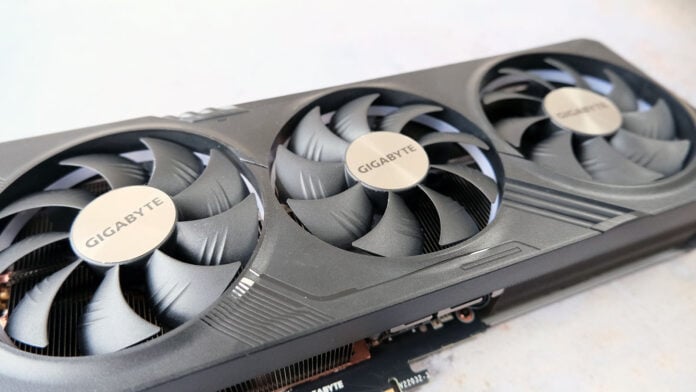Nvidia’s decision to release a trio of Super-equipped GeForce RTX 40 Series GPUs comes at an opportune time. Offering more performance than their non-Super namesakes through a select combination of more cores and higher memory bandwidth, there’s plenty to like. So much so, in fact, that Parm saw clear merit in GeForce RTX 4070 Super.
Now it’s the turn of the middle brother, also known as GeForce RTX 4070 Ti Super, to go under the review microscope. Priced at the same $799 as its namesake predecessor, there are manifest silicon changes afoot. Nvidia equips the GPU with greater horsepower by shifting the underlying die from full-fat AD104 to an optimised version of AD103, which, if you recall, also powers the faster RTX 4080 Super coming next week.
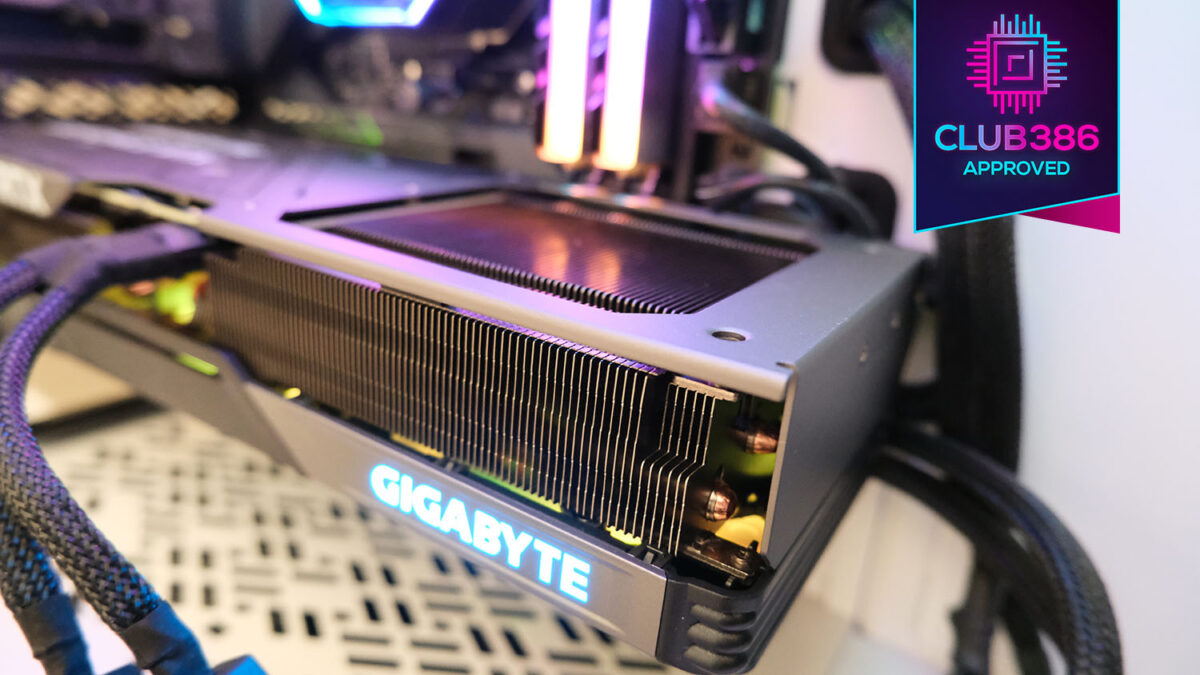
Gigabyte GeForce RTX 4070 Ti Super Gaming OC
£870 / $850
Pros
- Great build
- Premium performance
- DLSS 3 is impressive
- Overclocks well
Cons
- It’s huge
Club386 may earn an affiliate commission when you purchase products through links on our site.
How we test and review products.
Compared directly to RTX 4070 Ti, the natural upshot is 10 per cent more CUDA cores – 8,448 vs. 7,680 – more onboard RAM, and a wider memory bus offering 33 per cent extra bandwidth. These three facets arrive with no additional power consumption as Ti Super retains its sibling’s 285W TDP. Yes, there’s a reduction in ROPs, but that’s no big obstacle in the grand scheme of things.
In fact, RTX 4070 Ti Super has more in common with RTX 4080 than RTX 4070 Ti, and that’s a good thing, especially with no price increases in a world besieged by high inflation. Like before, there is no lovely Founders Edition card for this particular GPU, so it’s up to partners to build out quality cards that inevitably go head-to-head with rival AMD’s Radeon RX 7900 XT offerings that are recent beneficiaries of a price cut.
You’ve seen what Palit has to offer. Now it’s Gigabyte’s turn. Enter the £870 GeForce RTX 4070 Ti Super Gaming OC 16GB.
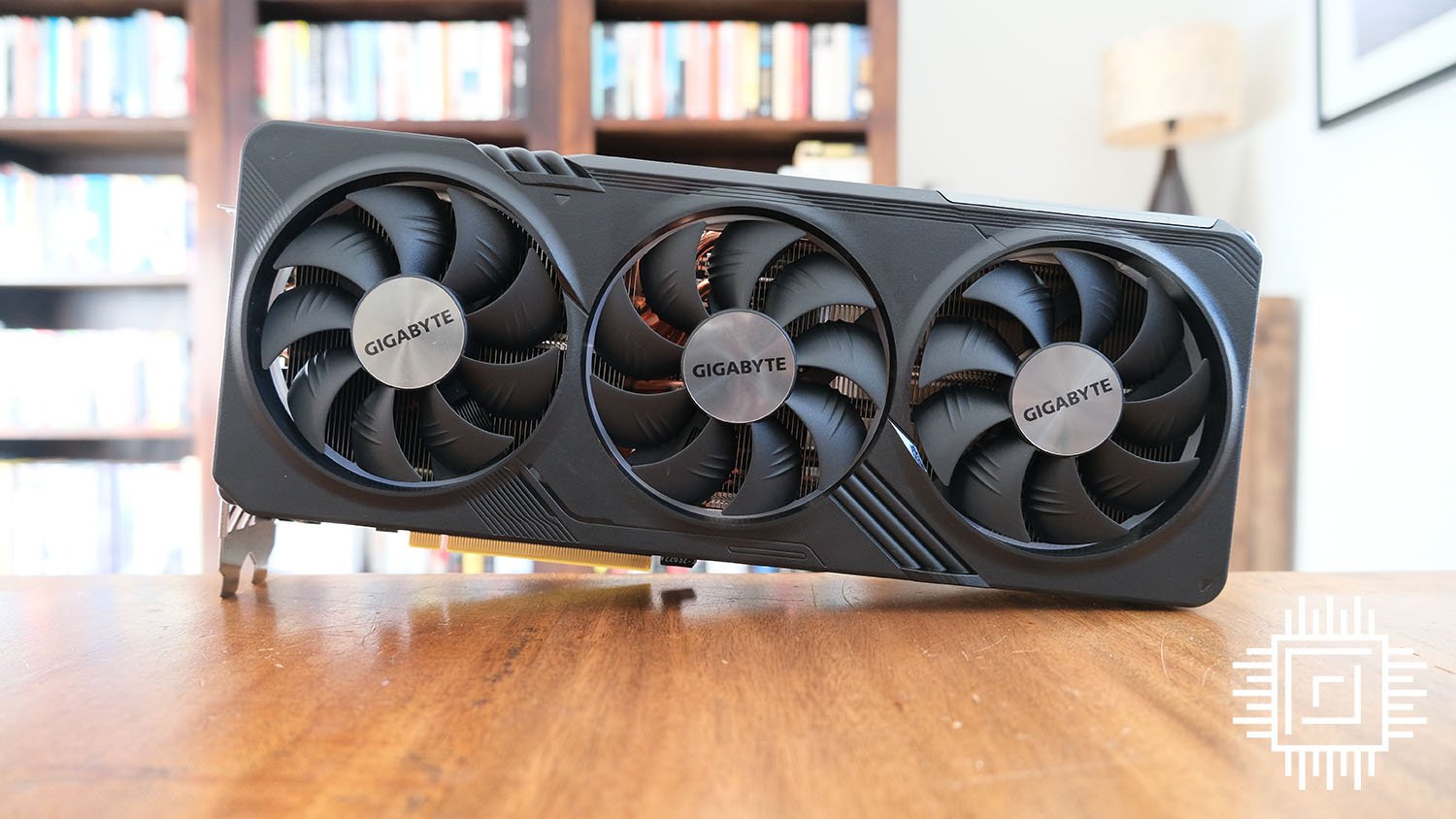
Got to say, I do like what Gigabyte is doing here. One of two cards using this GPU – the other’s a £799 Super Eagle OC – it’s a big old beast, alright. 300mm long, 130mm tall, and a considerable 57.6mm thick, the 1,280g behemoth ships with an anti-sag bracket. Nevertheless, thanks to impressive build quality, no sag is present in my test system.
Charging £80 more than bone-stock cards requires justification. Gigabyte does so with a marginally elevated core clock of 2,655MHz, compared to a standard 2,610MHz. Of more importance, it locks on to a 2,820MHz boost clock in most games, which is comfortably faster than the Palit.
Razzle Dazzle
The two outer fans spin anticlockwise whilst the centre rotates clockwise. This alternate nature reduces turbulence by a small margin. RGB illumination rings the trio, and it’s done well enough. You can set it to one of nine modes or choose a specific colour yourself.
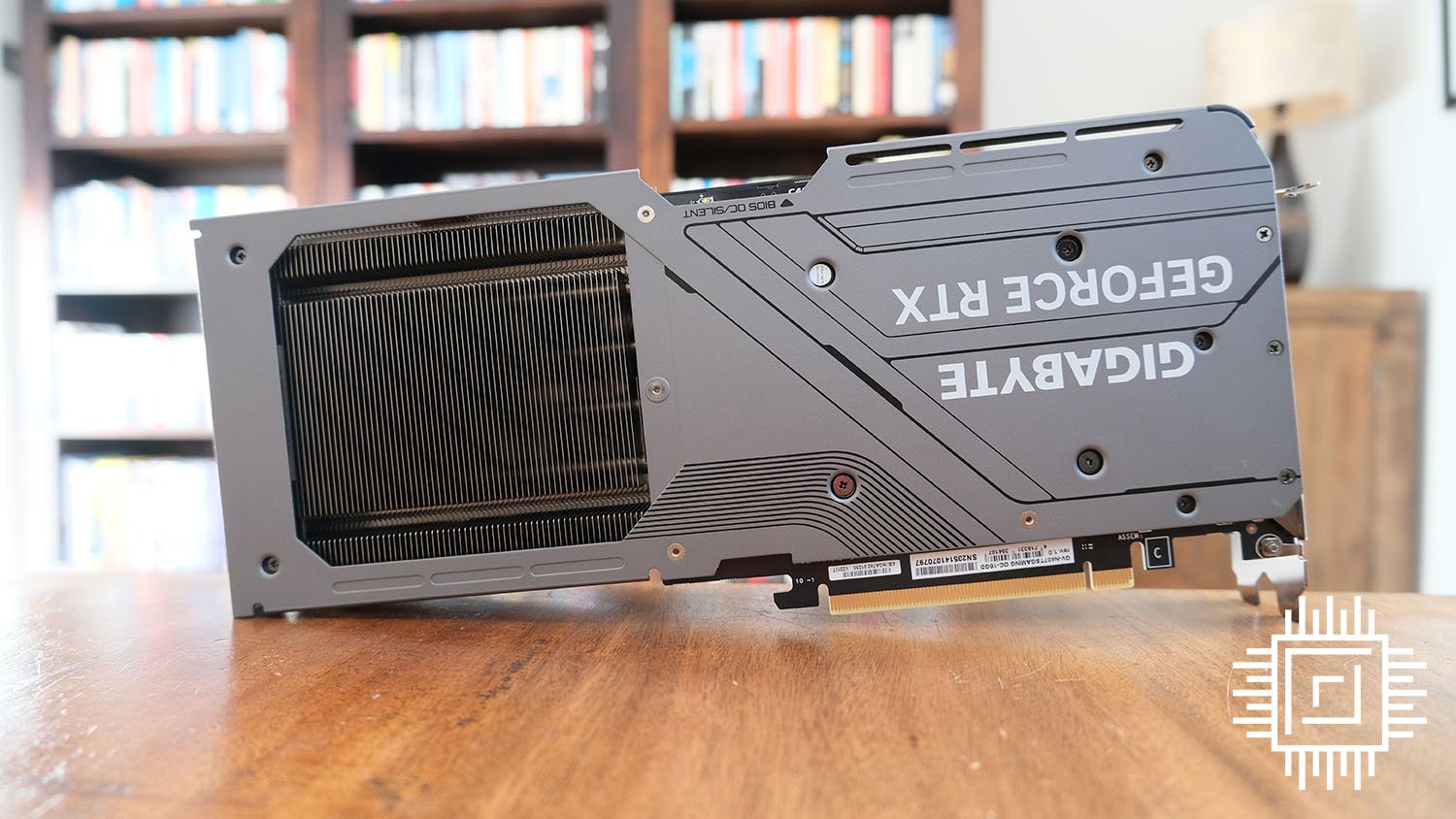
You may be surprised to note how short the PCB is. Look closely to find that it finishes before the meshed section on the left-hand side. There’s a 120mm overhang (not a typo) for through-the-heatsink cooling.
The full-width backplate is a nice touch, too. There’s no RGB illumination on this side, but the nature of the PCB and cooling means light easily spills through to this section. The effect is somewhat distracting when using the default ‘dazzle’ profile. I’d recommend you change to something more sober like ‘Color Shift.’
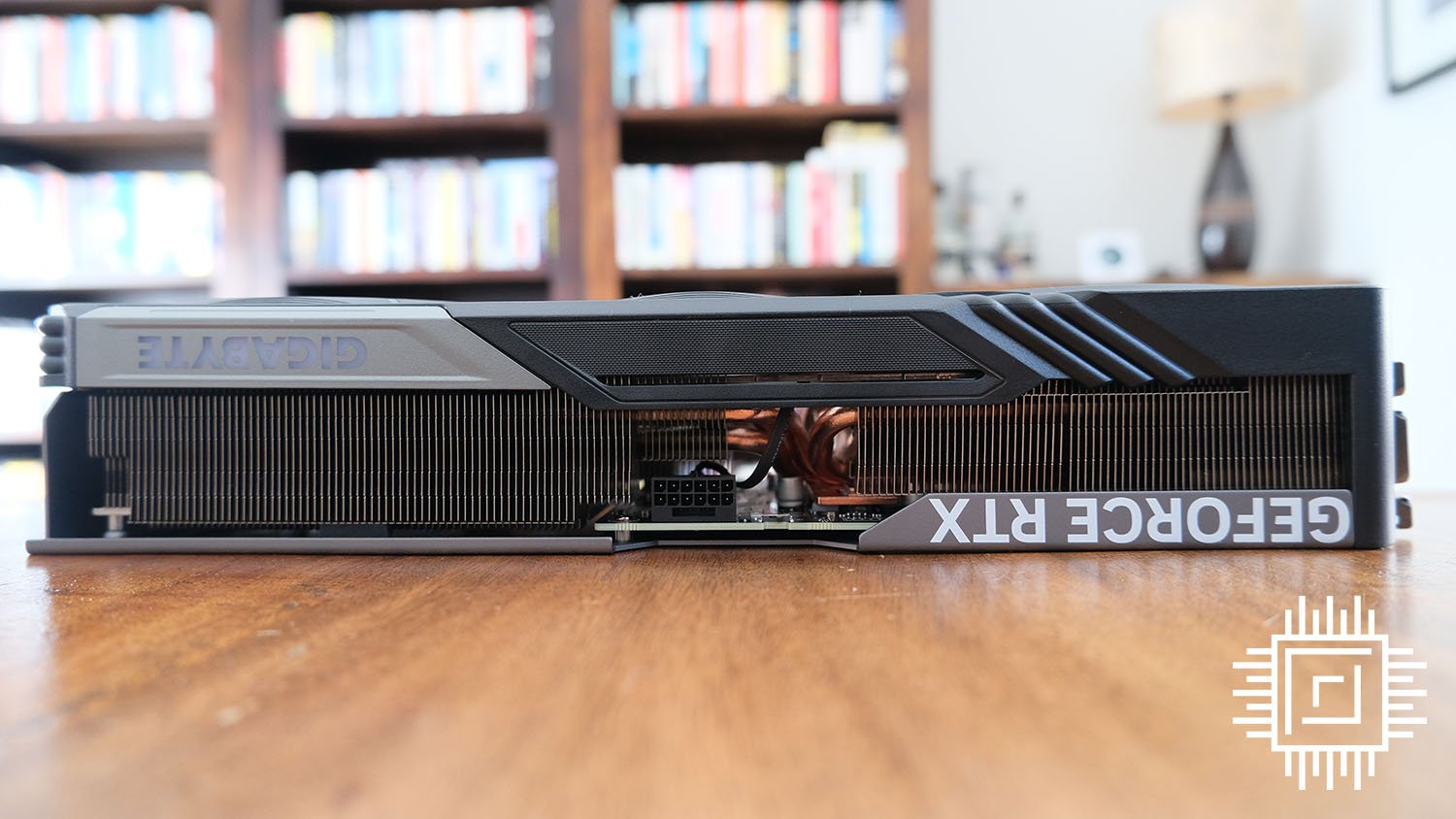
Gigabyte’s logo also shines up. Sensibly placed, it’s the part of the card that’s nearest the user when installed in a standard horizontal format. Syncing between logo and fans is excellent; both produce identical hues time-matched accurately.
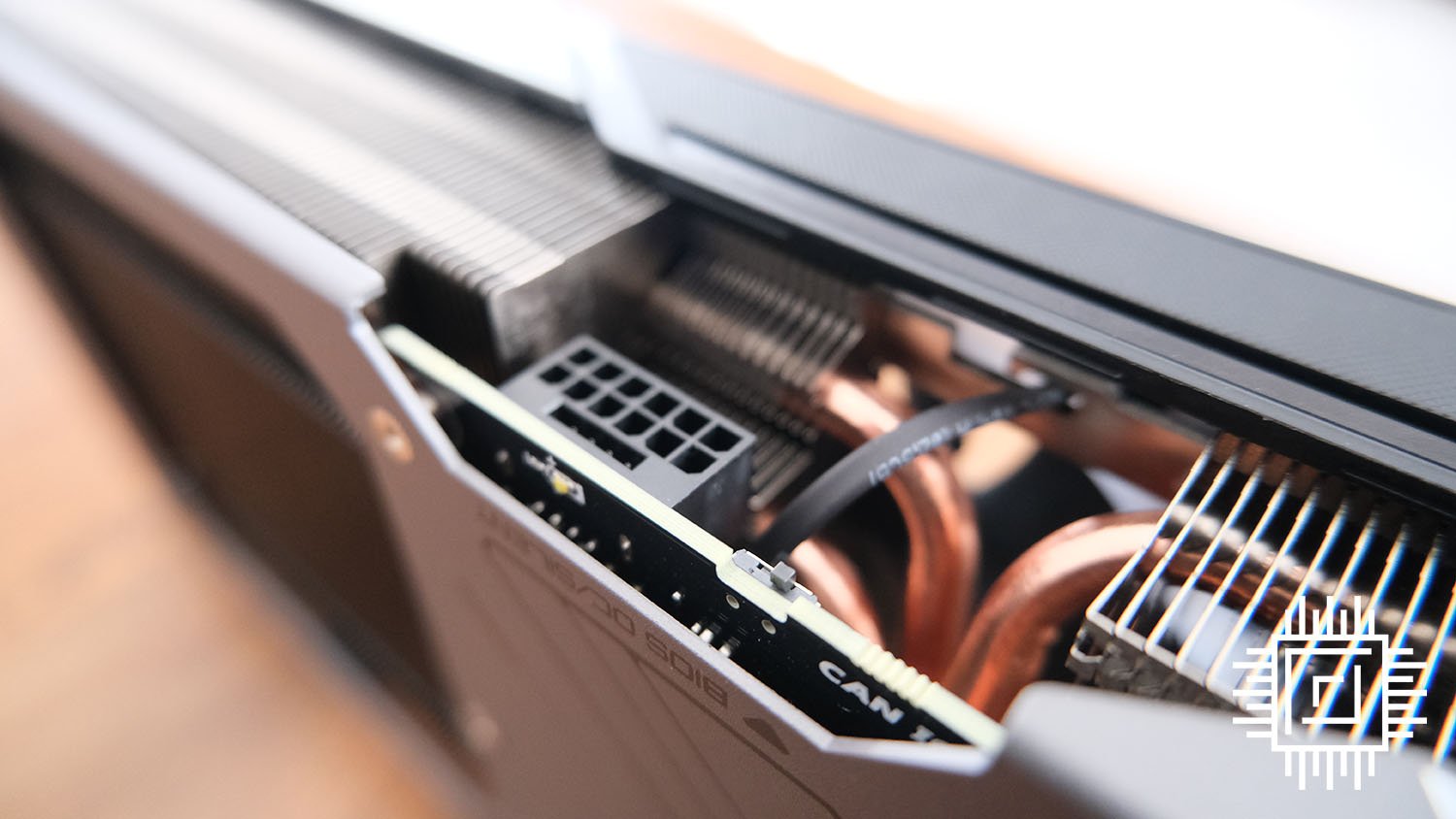
The infamous 12VHPWR connector takes centre stage between the massive heatsink that successfully covers all hot-running components. Next to it resides a BIOS-changing switch toggling between default and silent modes. In my brief testing between states, you lose around 2% of performance for a 1.5dB reduction in noise. I’d keep it in the standard mode, however, as the card’s pretty quiet as is.
16GB of GDDR6X memory, meanwhile, hums along at a default 21Gbps. Partners have shied away from touching memory speed because it’s difficult to screen for overclocking potential when set against multi-vendor RAM procurement.
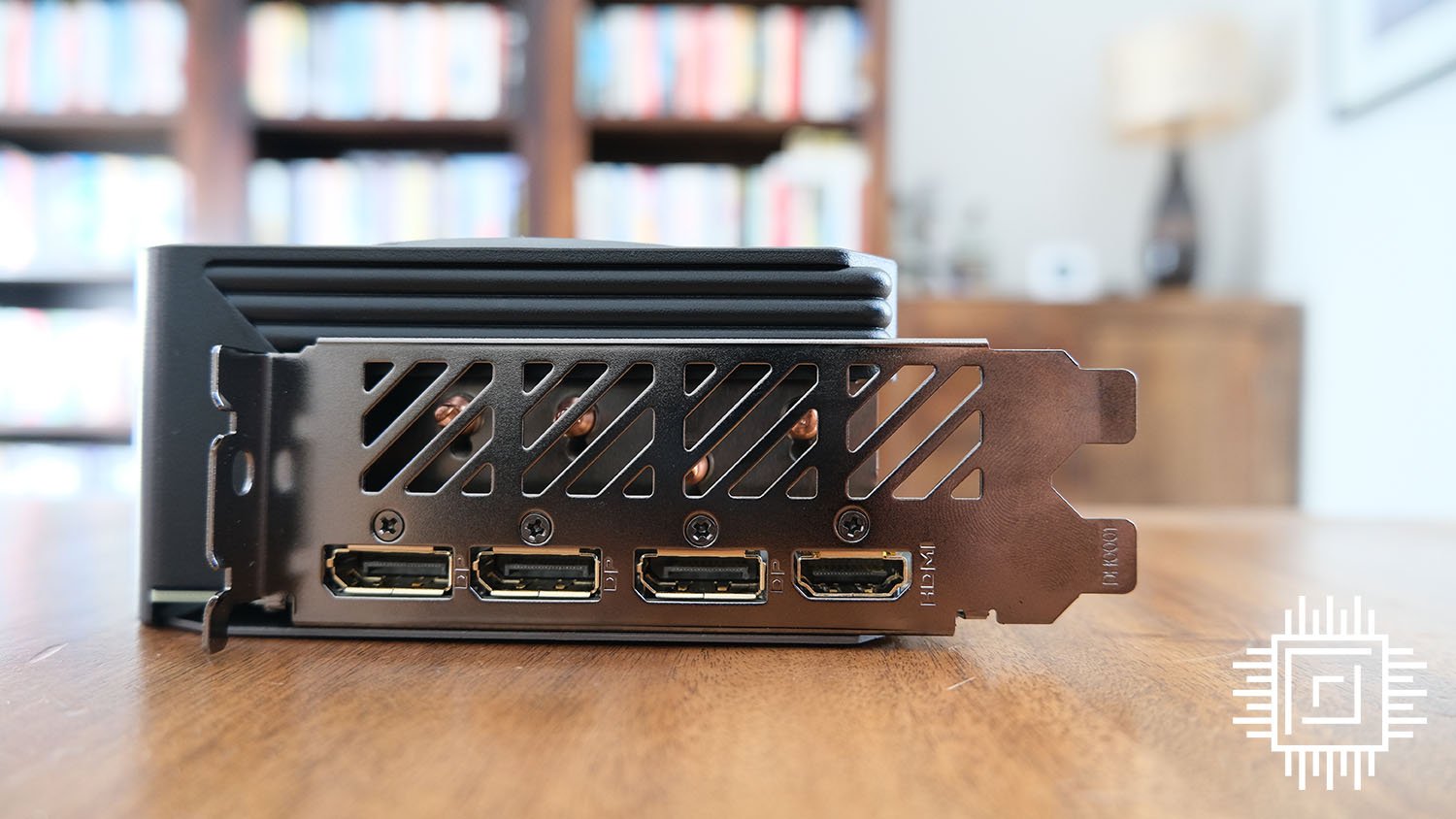
The sheer height is evidenced by the comparatively small I/O bracket comprising three DisplayPort 1.4a and a single HDMI 2.1a. Being picky, the bracket would look good in black, mirroring the card’s stealthy aesthetic.
Gigabyte doesn’t publish actual card power, though going by my testing, it’s between 300-310W when under the pump. It’s also worth knowing the card’s backed by a four-year warranty, which is a year longer than most.
Performance
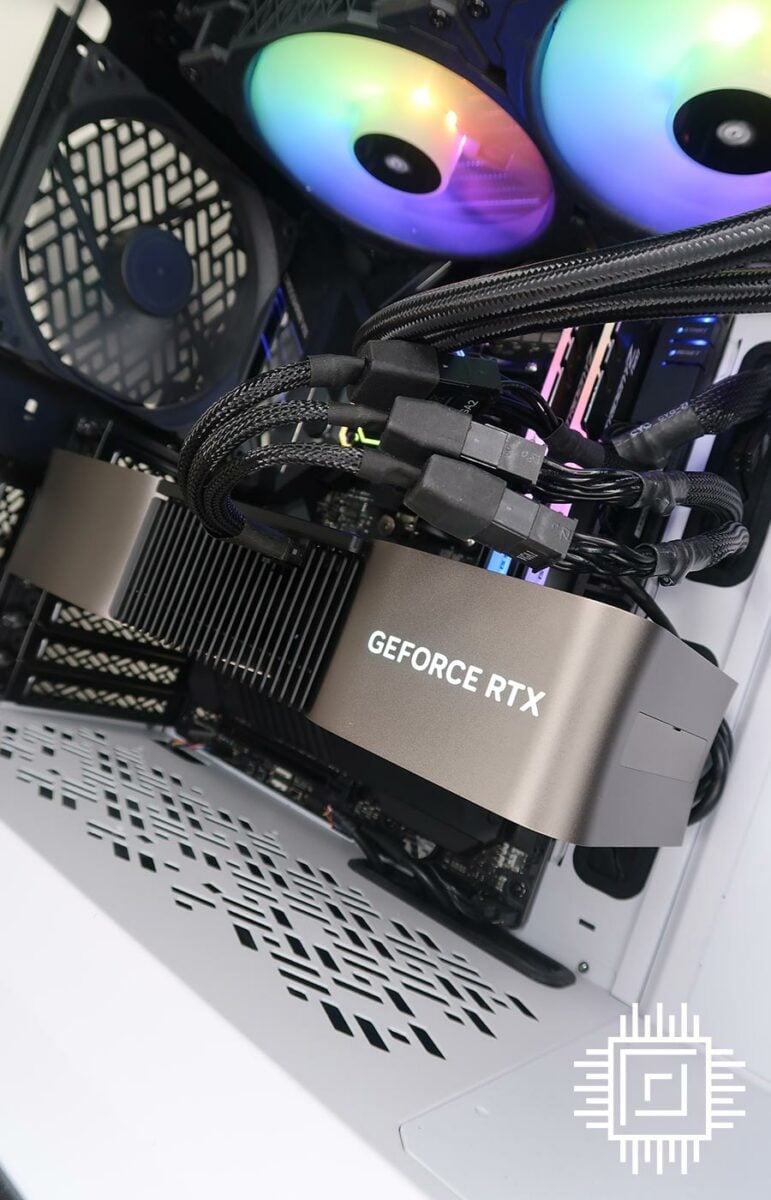
Our 5950X Test PCs
Club386 carefully chooses each component in a test bench to best suit the review at hand. When you view our benchmarks, you’re not just getting an opinion, but the results of rigorous testing carried out using hardware we trust.
Shop Club386 test platform components:
CPU: AMD Ryzen 9 5950X
Motherboard: Asus ROG X570 Crosshair VIII Formula
Cooler: Corsair Hydro Series H150i Pro RGB
Memory: 32GB G.Skill Trident Z Neo DDR4
Storage: 2TB Corsair MP600 SSD
PSU: be quiet! Straight Power 11 Platinum 1300W
Chassis: Fractal Design Define 7 Clear TG
Our trusty test platforms are nearing retirement, yet it is it testament to the Ryzen 9 5950X build that our twin AM4 rigs continue to function reliably irrespective of the numerous graphics cards thrown at it.
3DMark
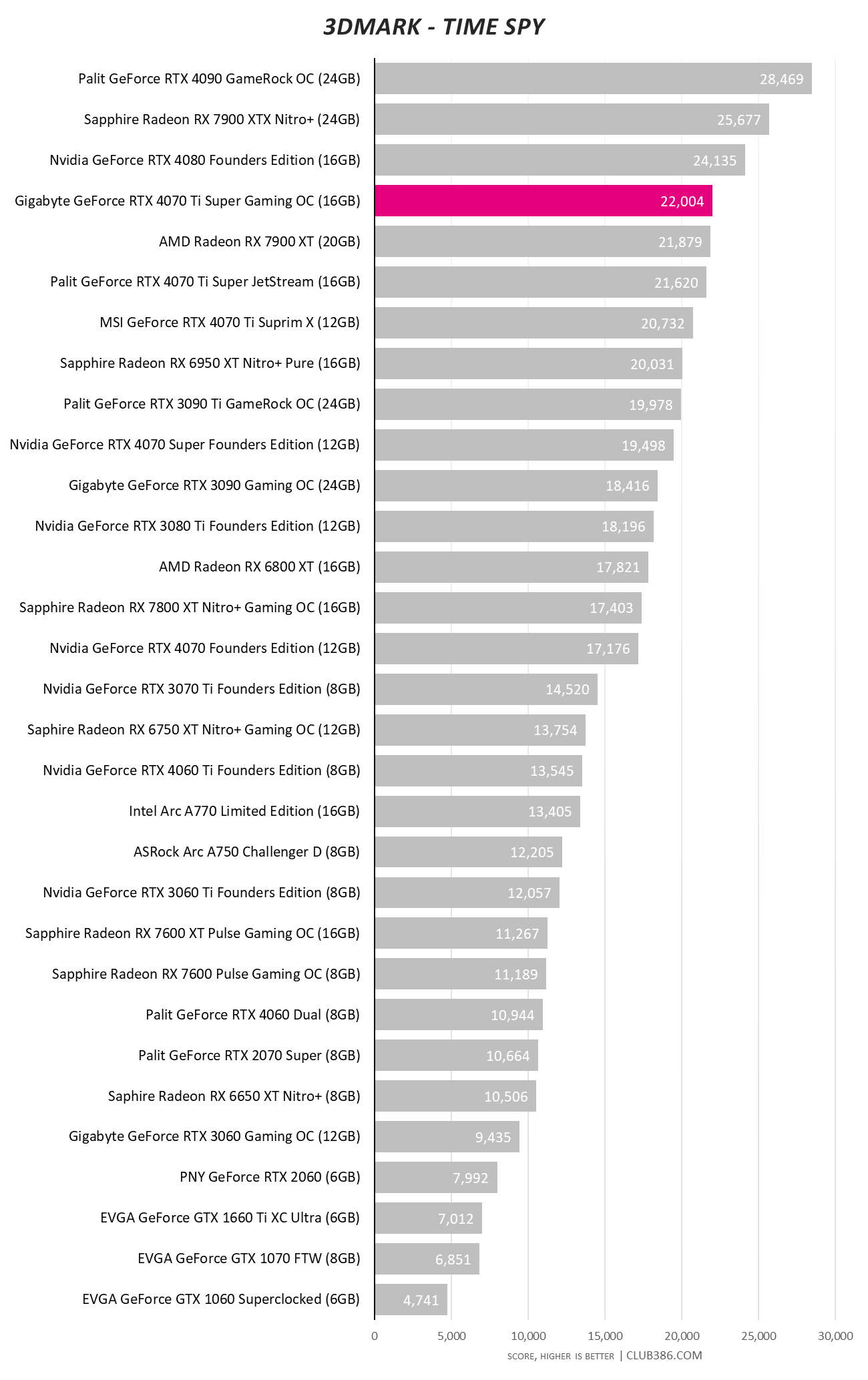
Gigabyte pulls out a 384-mark lead over the Palit GeForce RTX 4070 Ti JetStream by dint of its faster core clock. Enough, actually, to create an RTX 4070 Ti Super sandwich around the RX 7900 XT.
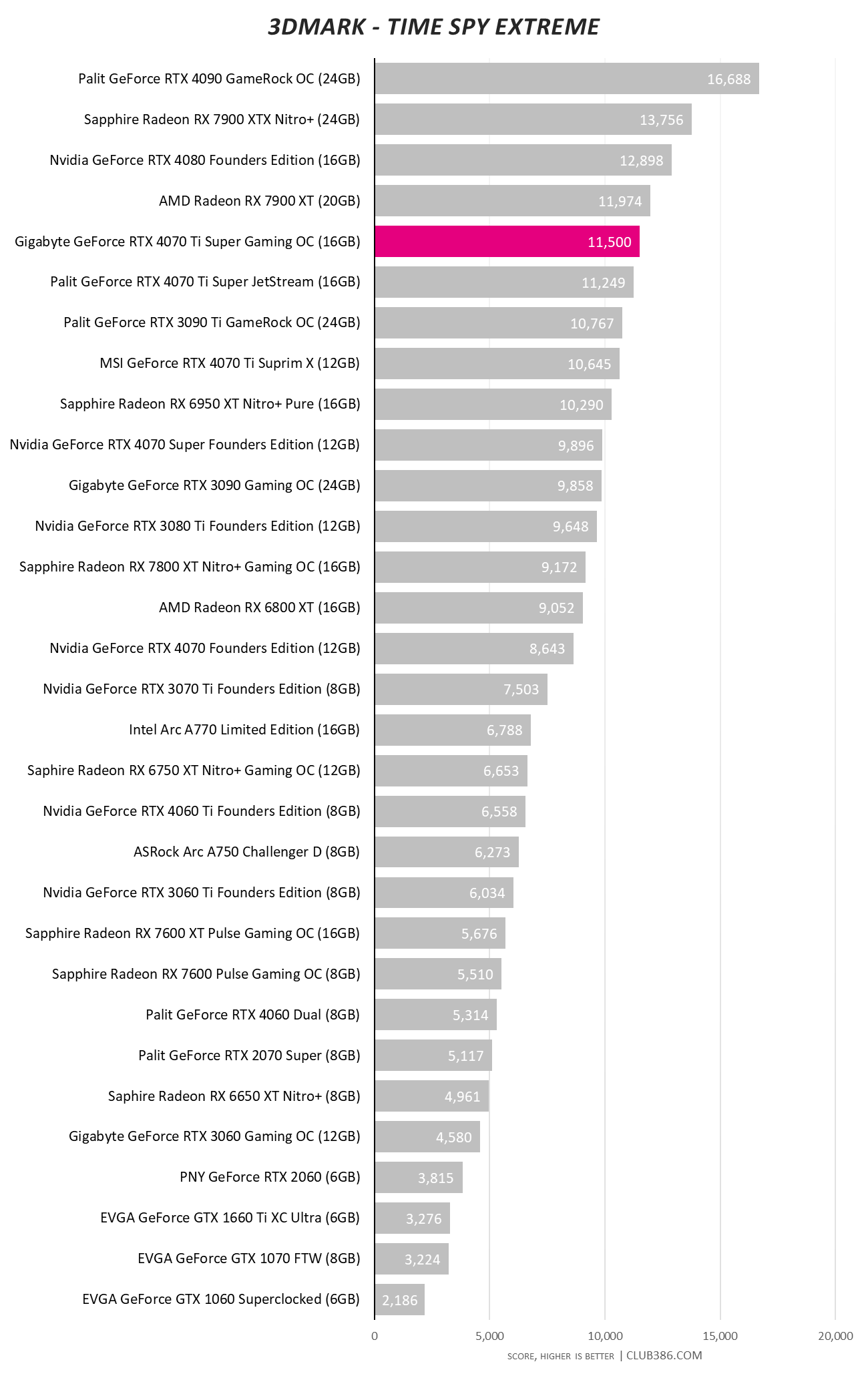
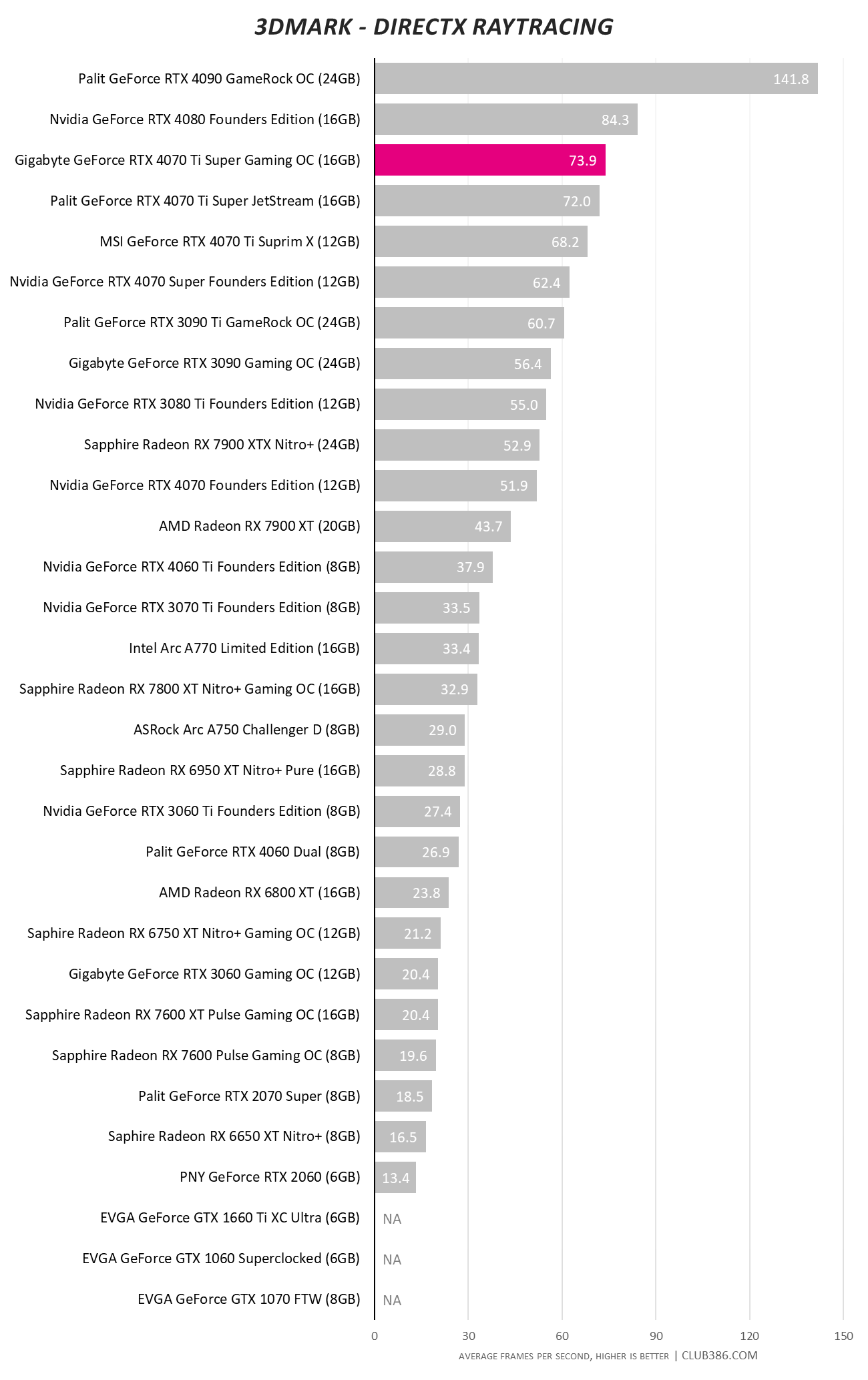
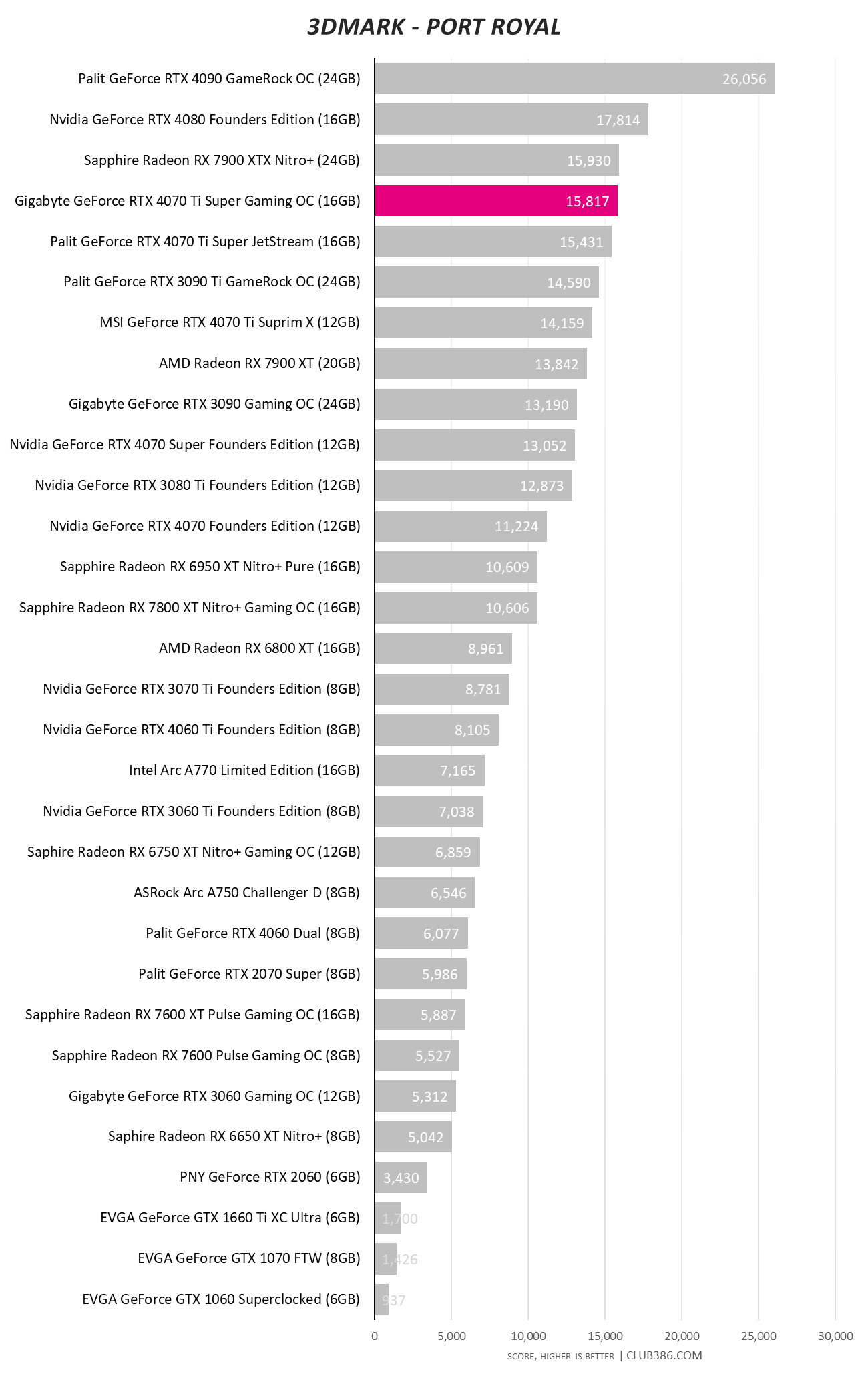
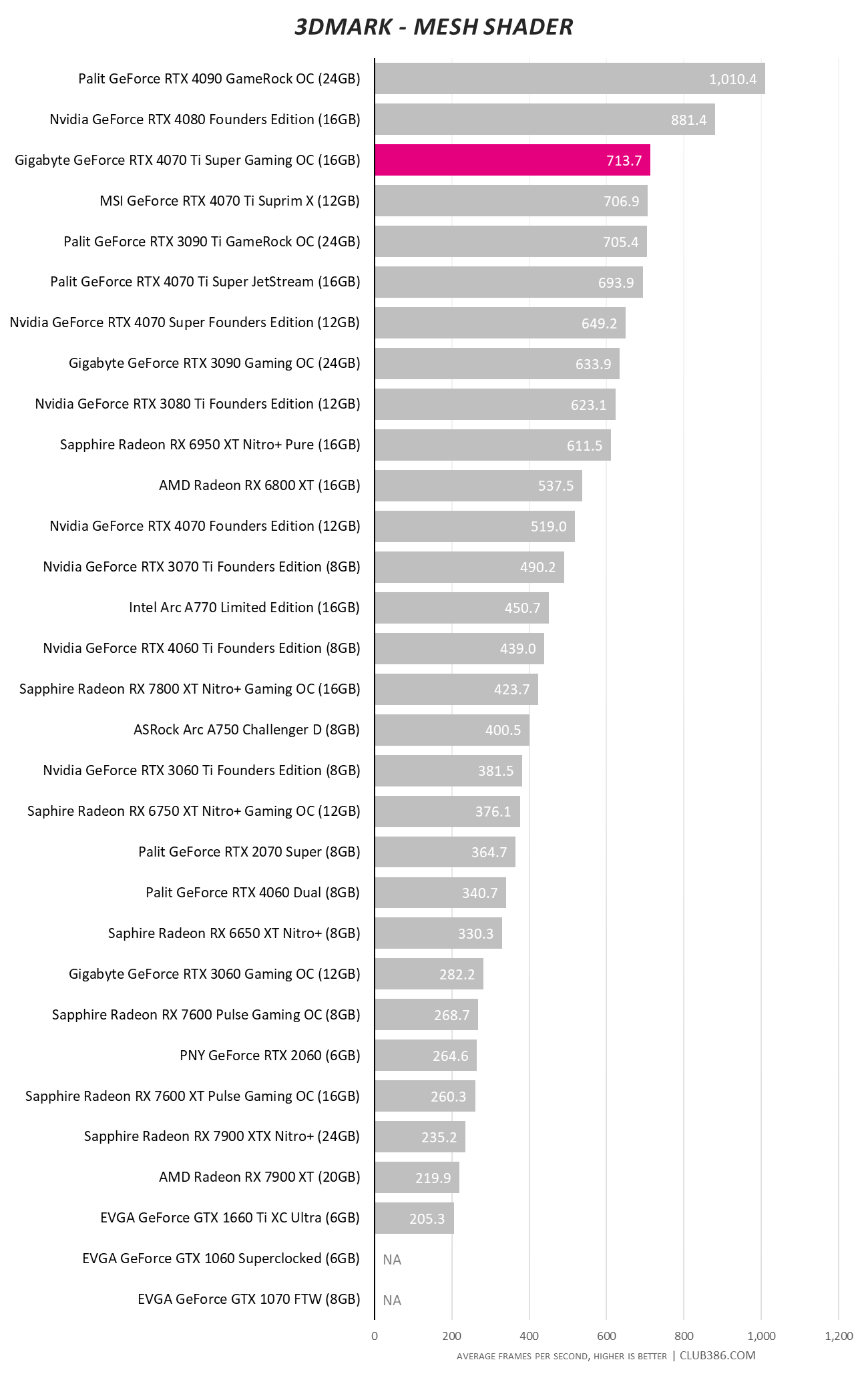
Furthermore, synthetic tests show the Gaming OC to have the better of rival AMD Radeon RX 7900 XT / XTX in most tests.
Gaming
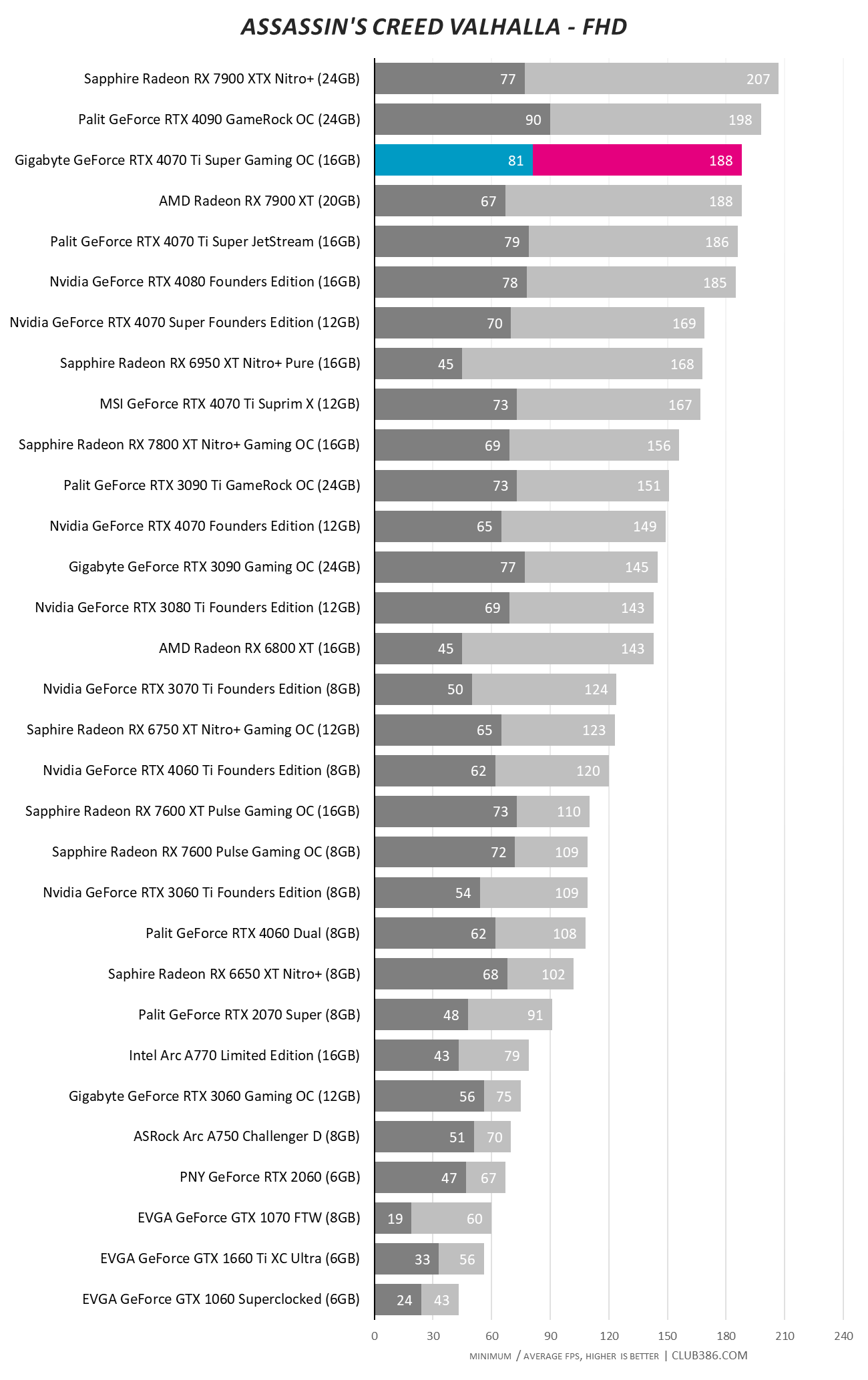
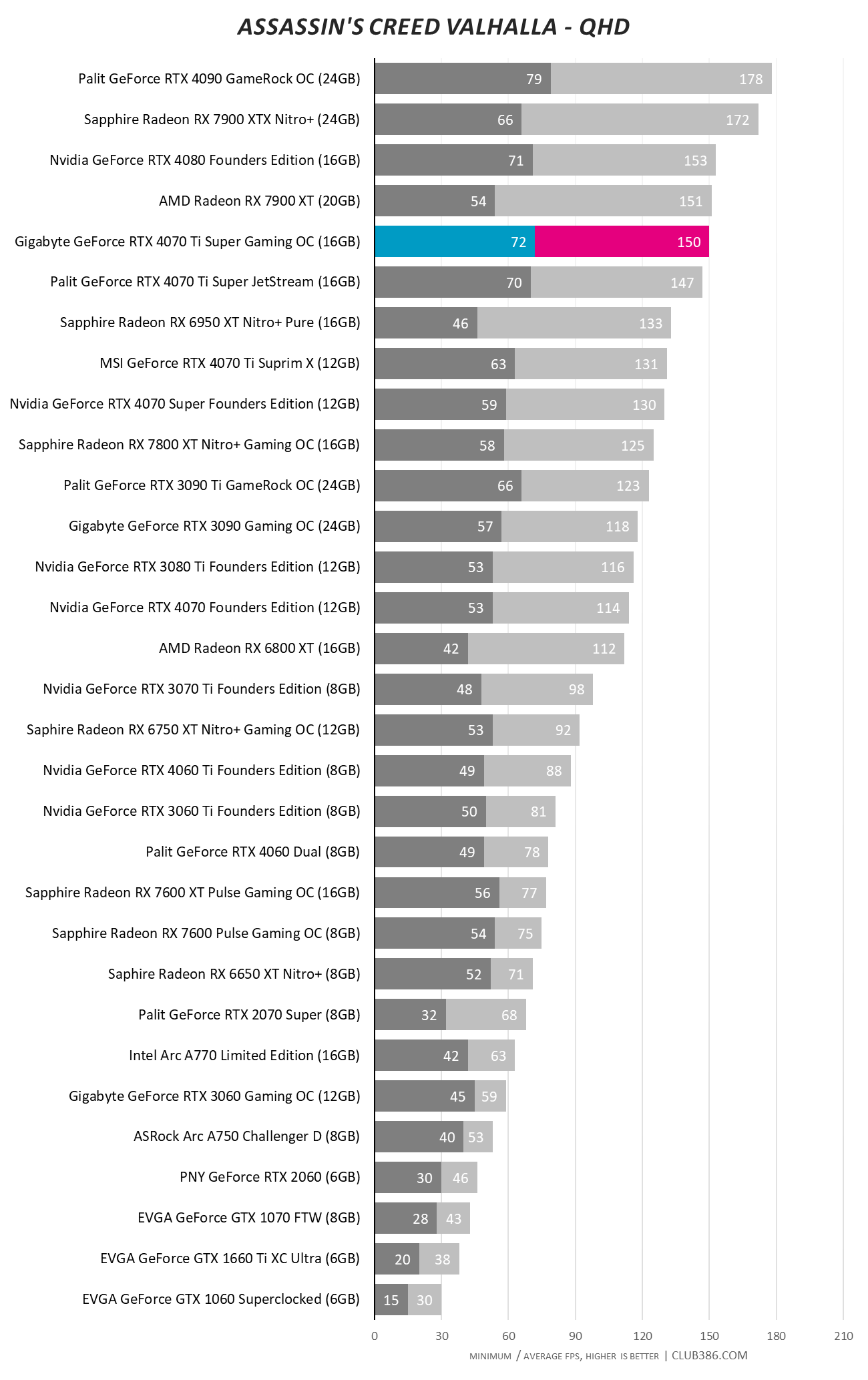
Moving on to gaming, performance is razor-sharp at QHD. Nevertheless, it remains slightly below price-comparable Radeon cards.
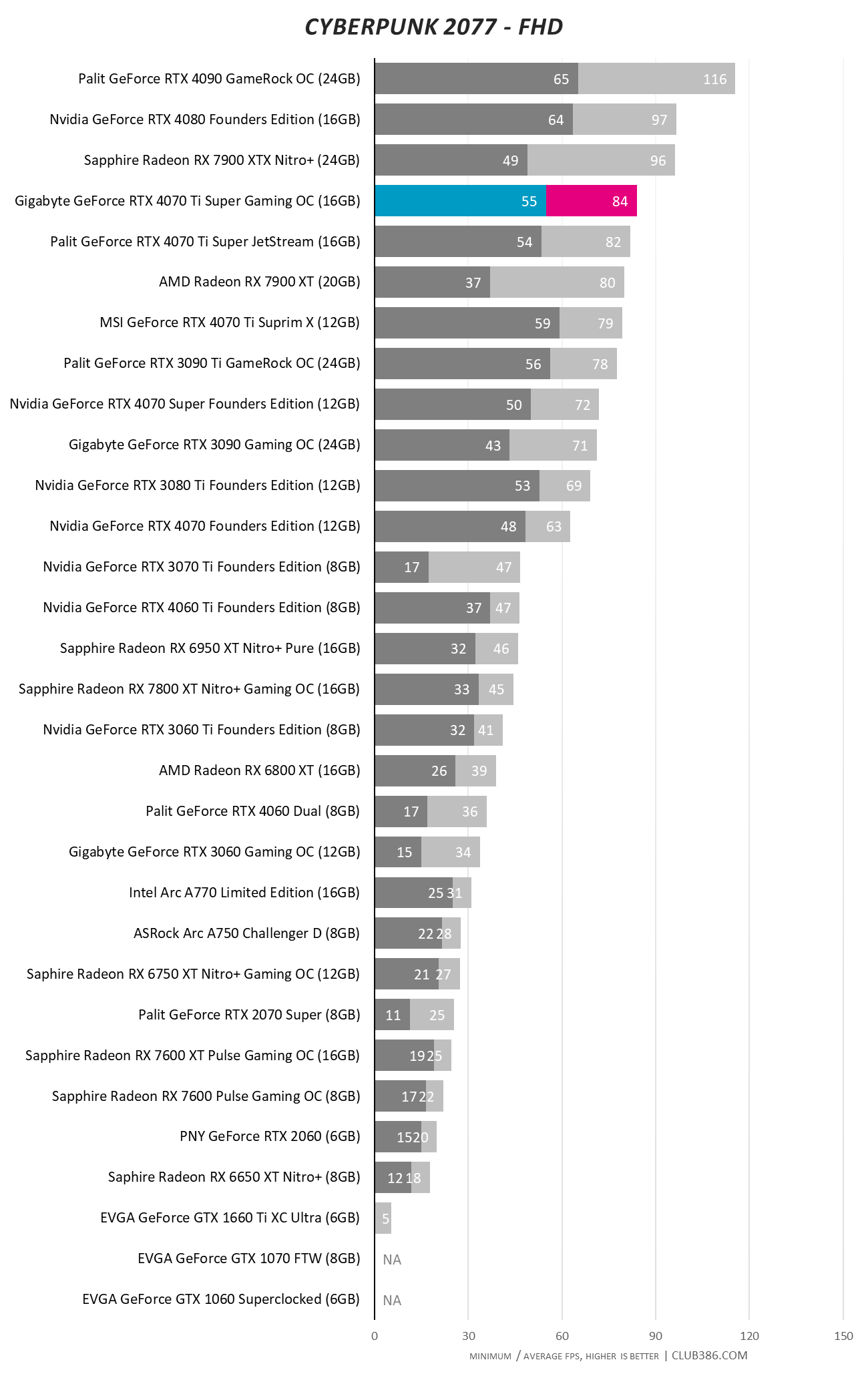
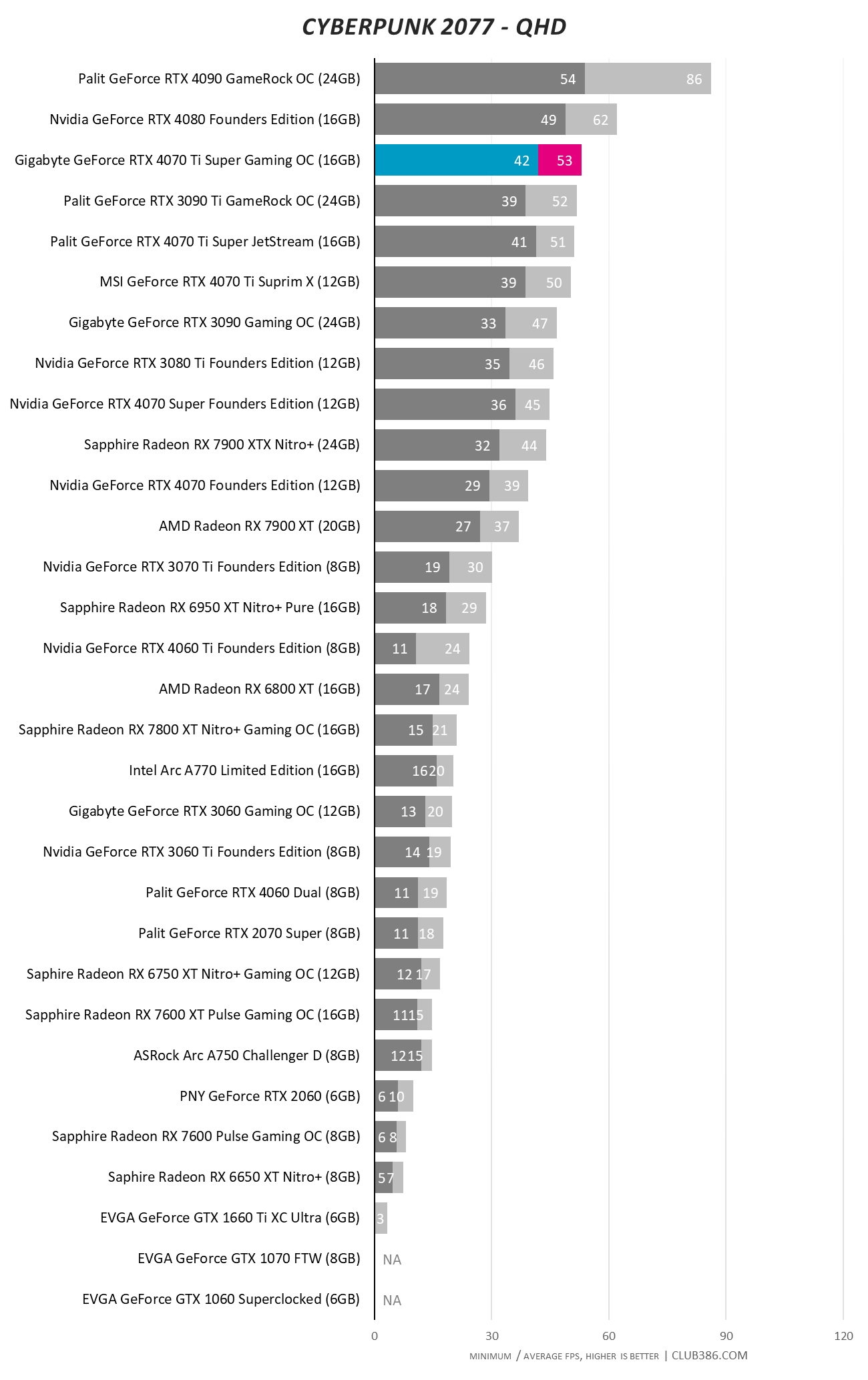
Run with maximum hurt enabled through the ray tracing ultra preset – I love seeing cards struggle – you’re looking at GeForce RTX 3090 Ti-beating numbers. Recall that card cost $1,999 less than two years’ ago.
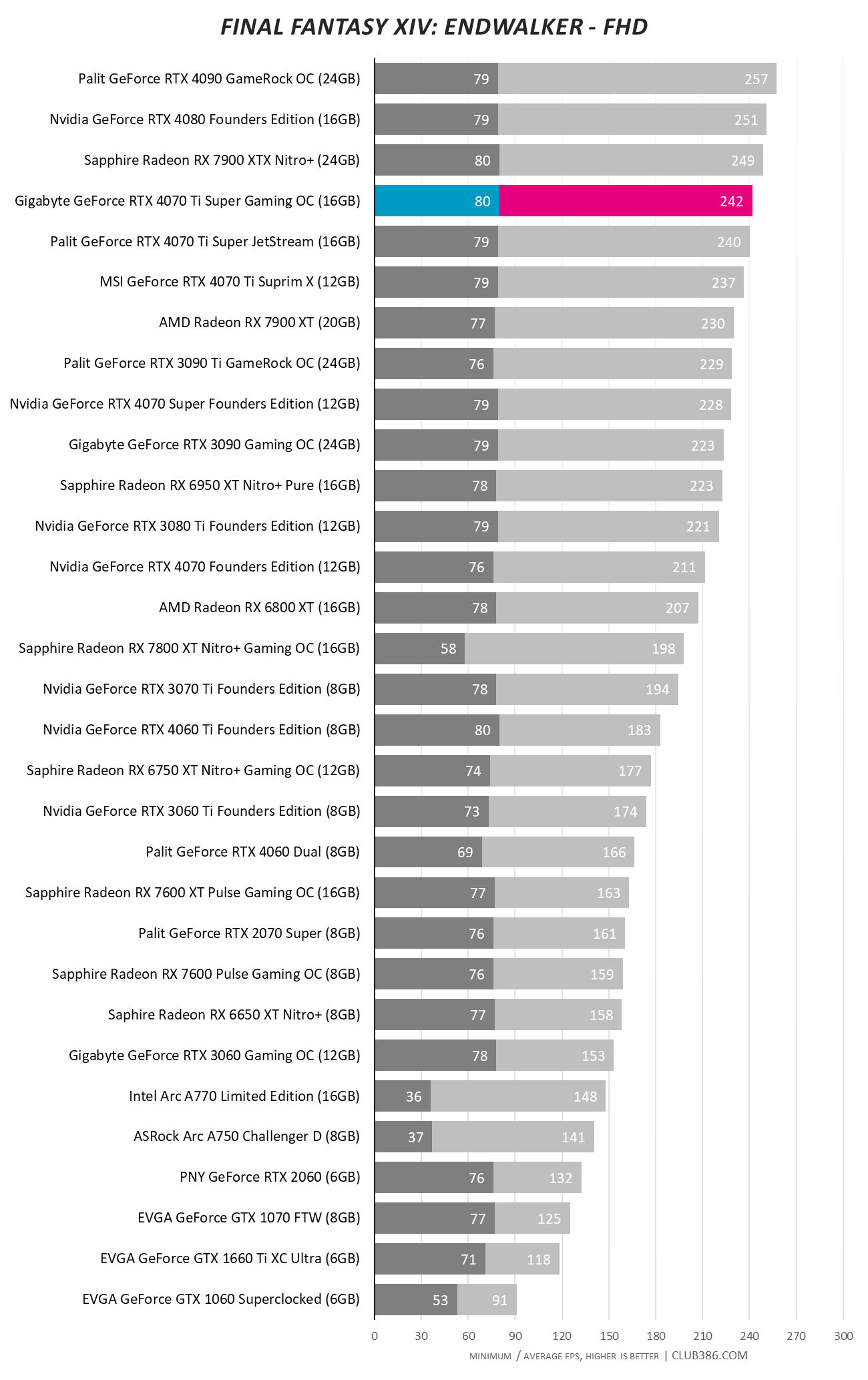
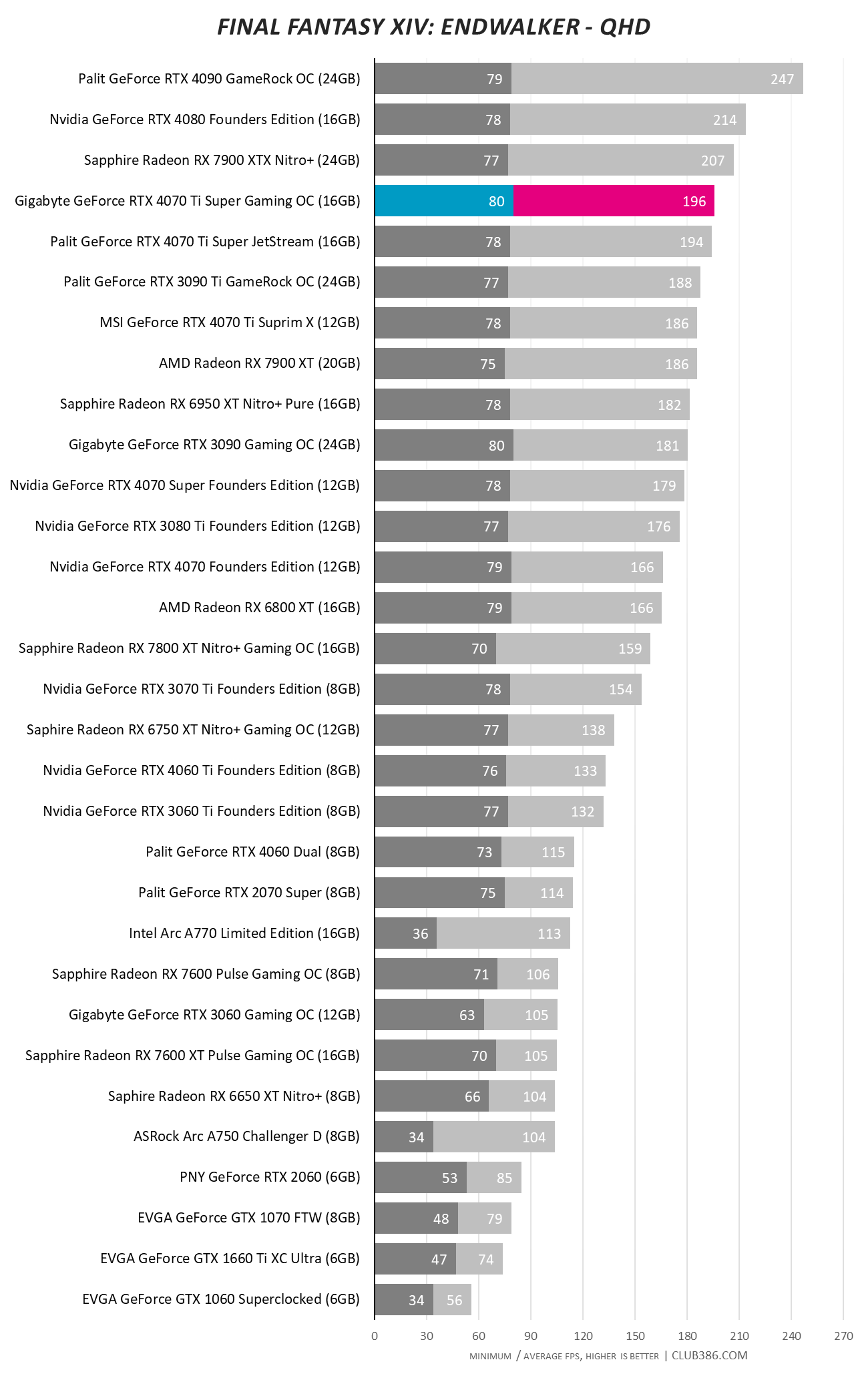
This beast makes a great case for a high-framerate QHD offering. Just as well there are plenty of compatible monitors out there.
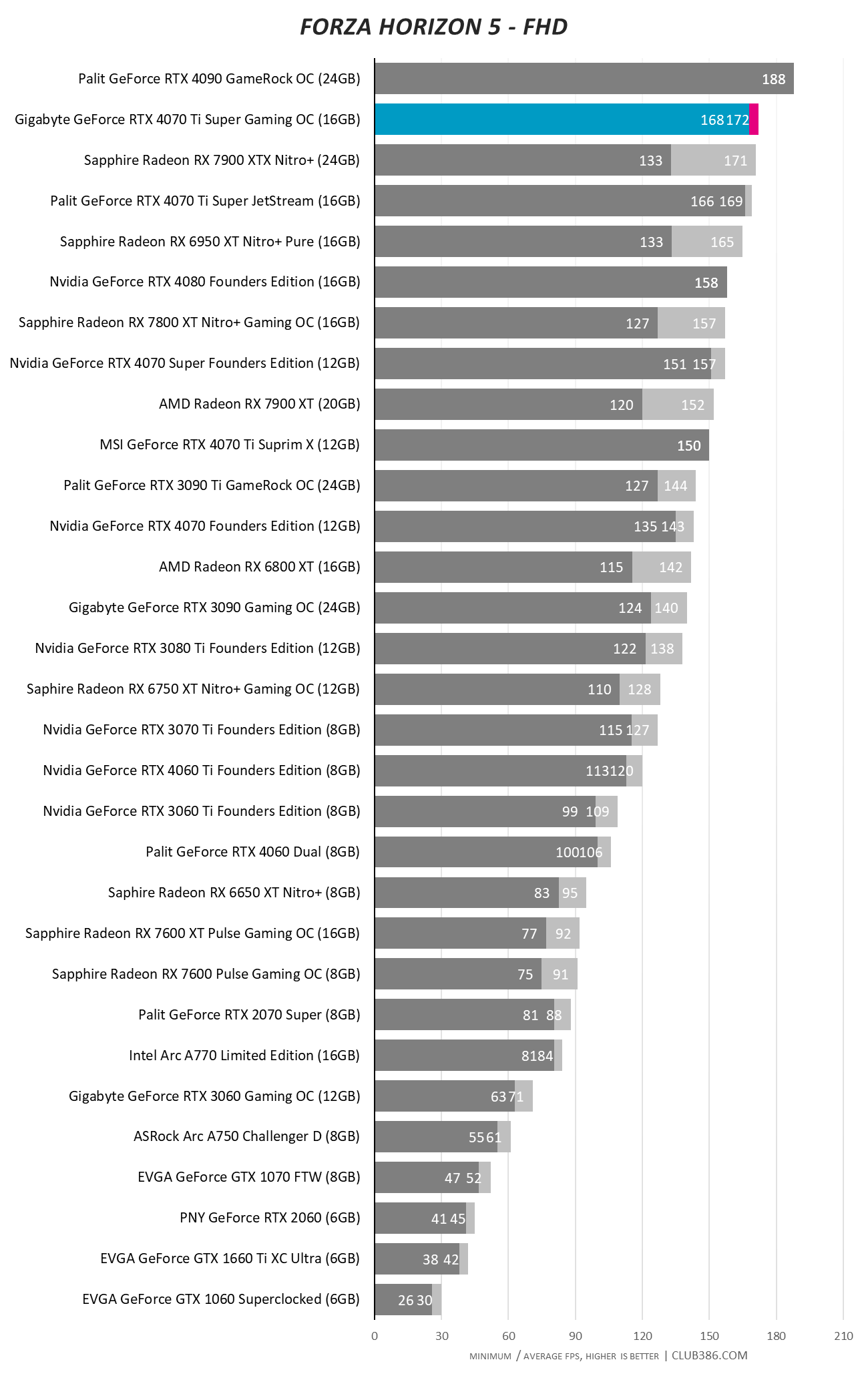
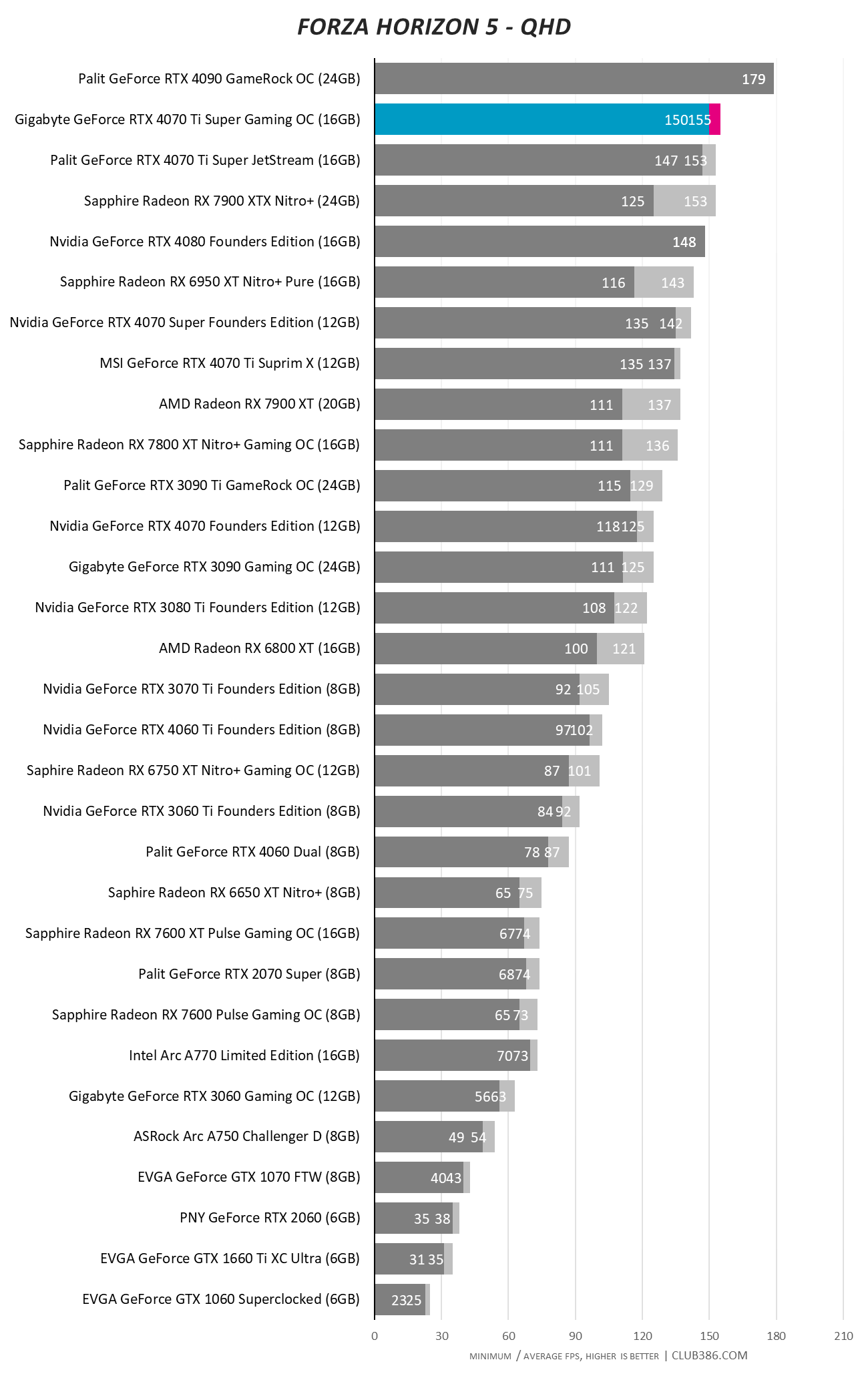
Barely losing any performance between resolutions, there’s little to criticise.
Efficiency
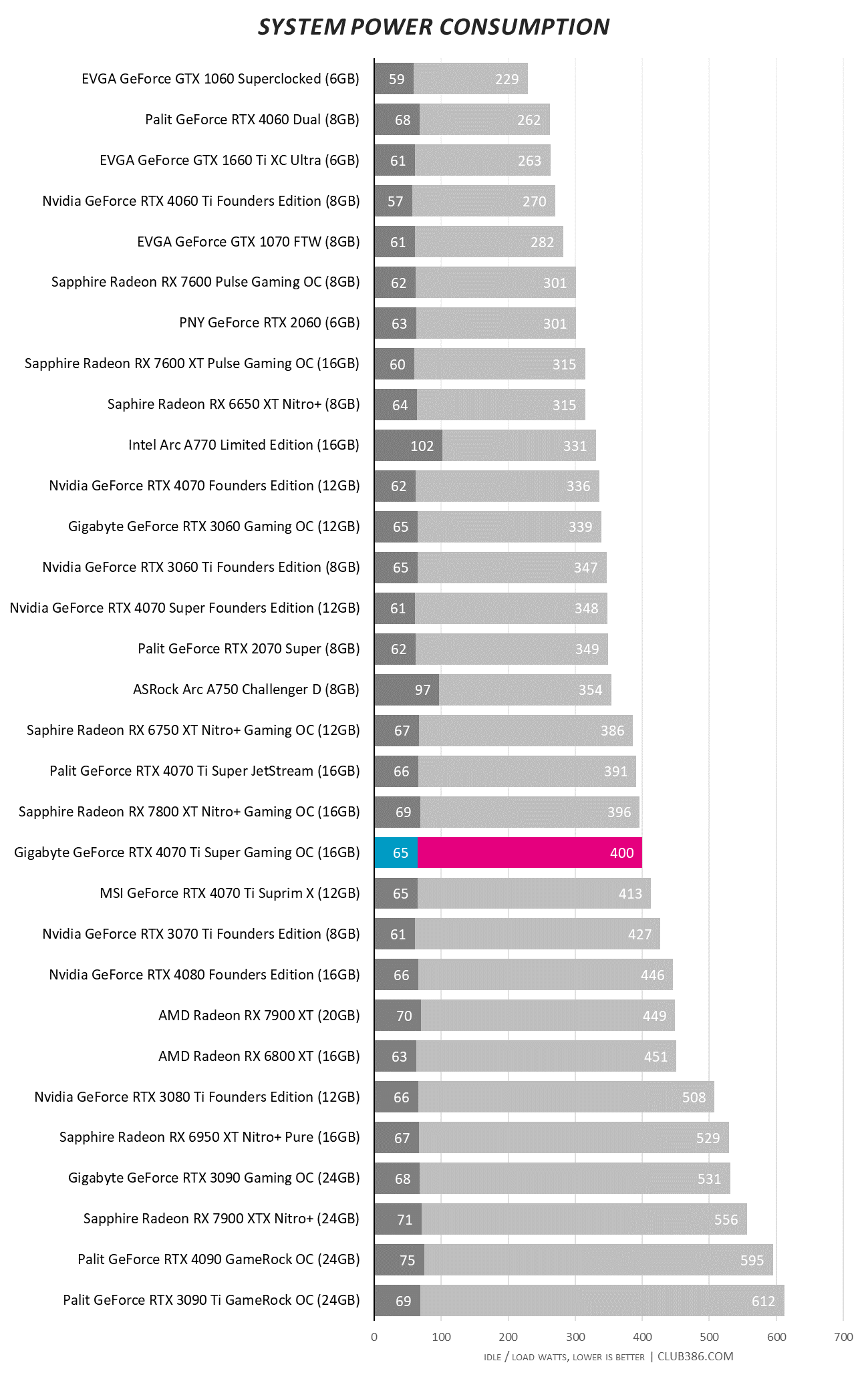
It’s interesting to see the card take fewer watts than an MSI GeForce RTX 4070 Ti Suprim X. It’s also naturally far more frugal than a last-generation RTX 3090 Ti that it routinely beats in the performance stakes.
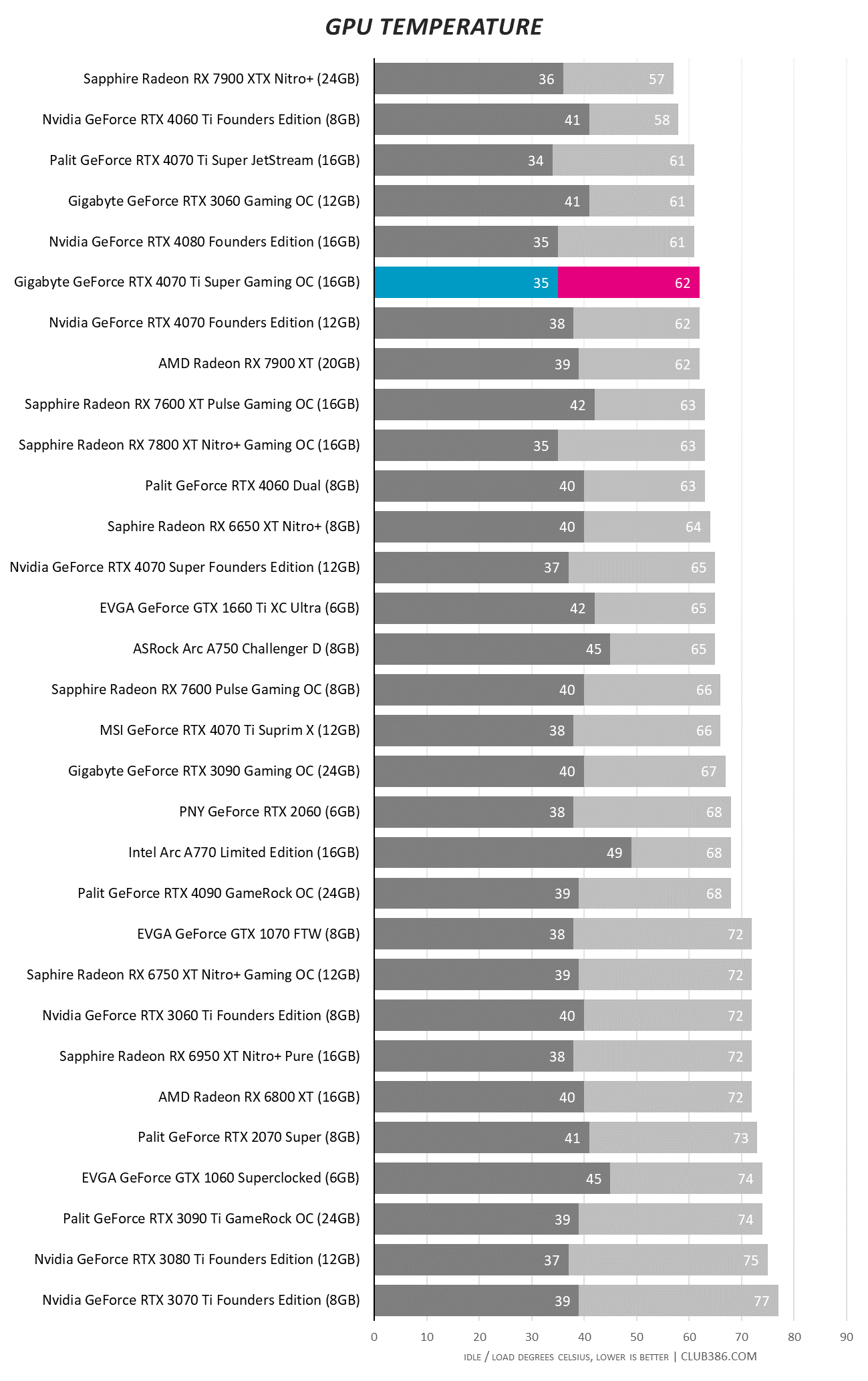
A big, hulking cooler can only mean one thing: low temperatures. Gigabyte’s three-fan solution is more than a match for the 300W or so TDP.
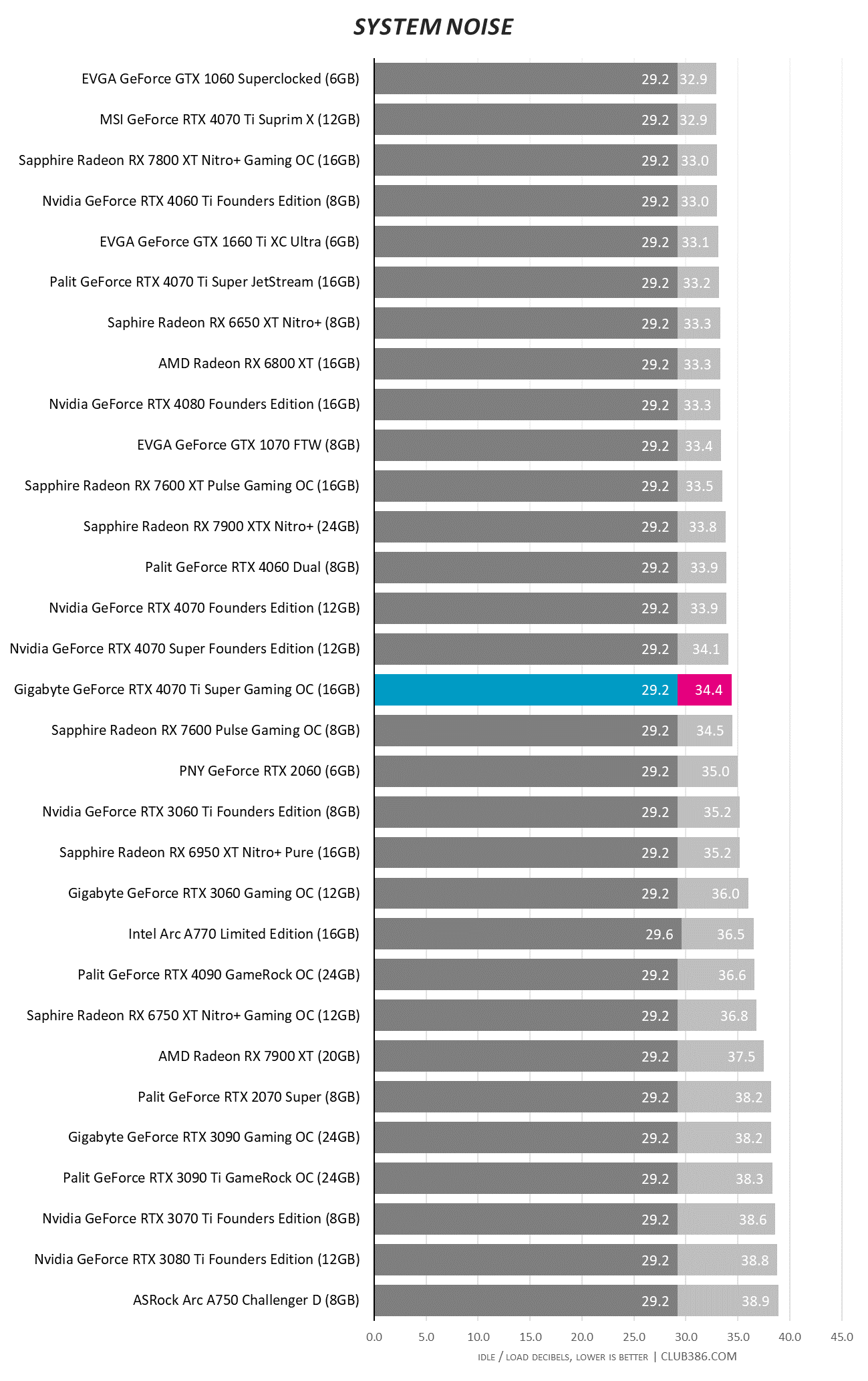
Not the quietist, for sure, but certainly not what I’d call loud. There’s a steady hum whose pitch is consistent and not overly distracting.
Running a high-framerate games exhibits minor coil while. Of course, I’m looking at a sample of precisely one, but I don’t expect the card you buy to suffer from wretched squealing when playing Overwatch.
Relative performance
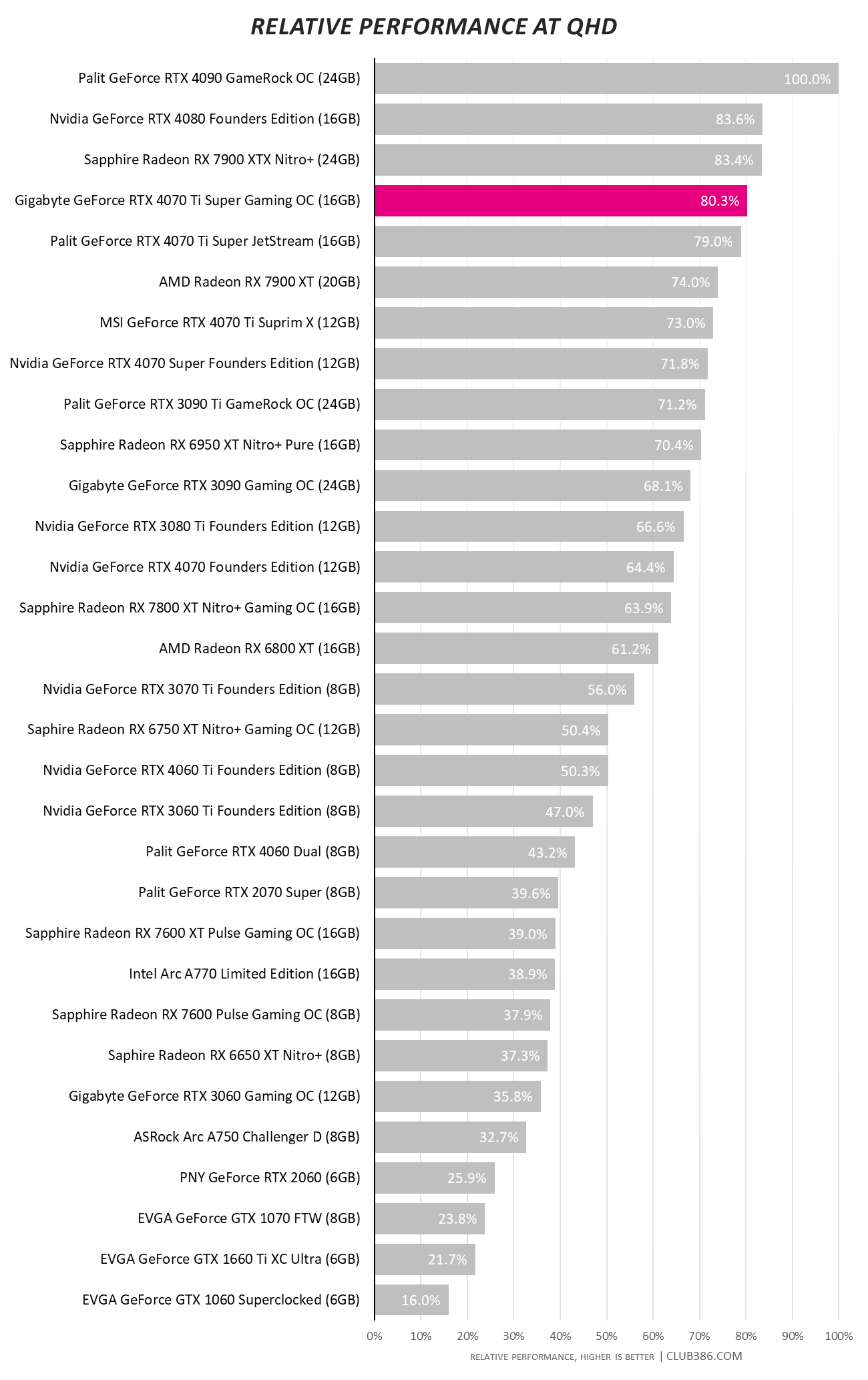
Putting it all together shows GeForce RTX 4070 Ti Super is a solid performer. Behind cards that are typically more expensive, the £870 pricing feels about right for a premium GPU.
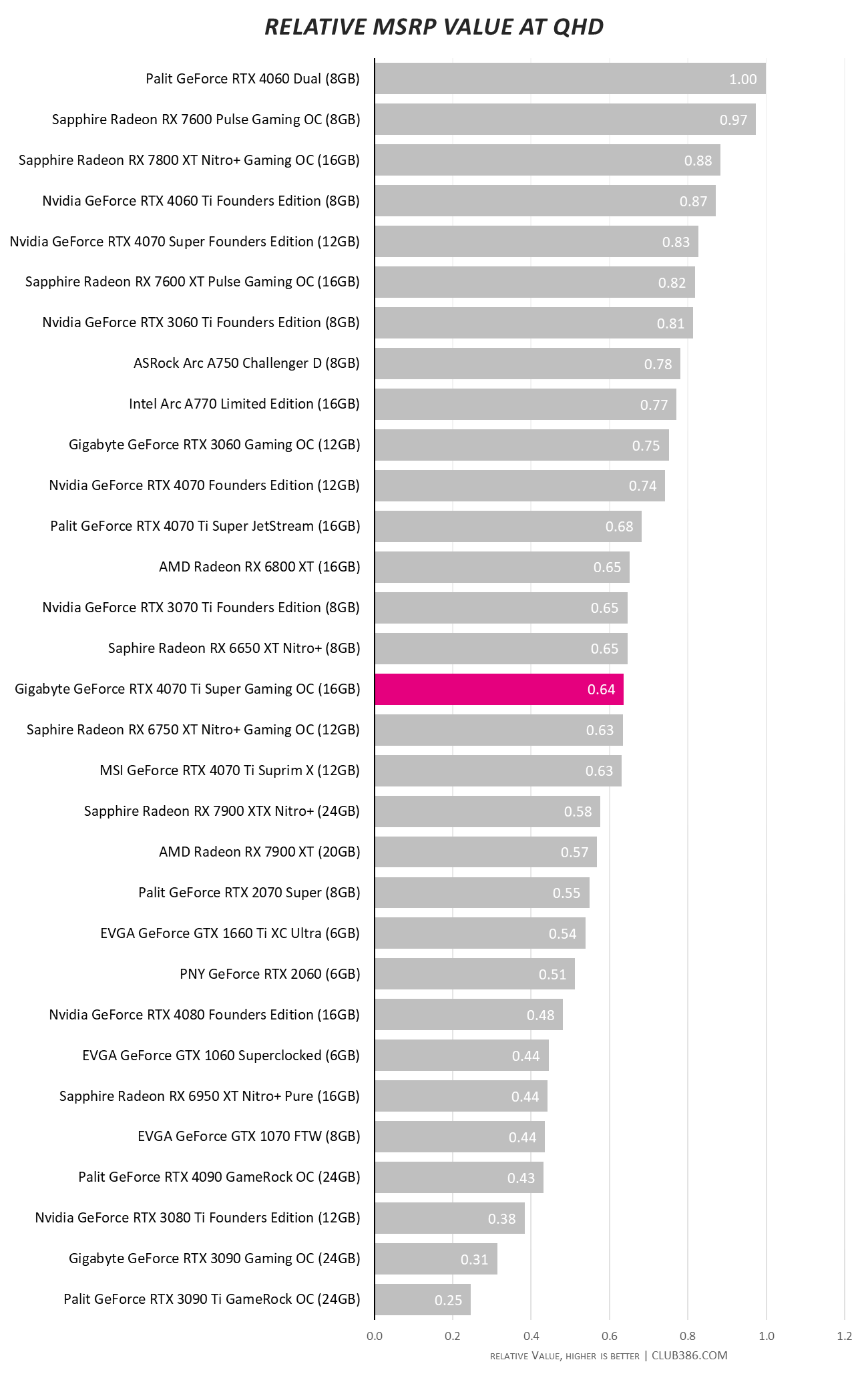
I’d expect around mid-pack performance here. Cards such as Radeon RX 7900 XT, 7900 XTX, RTX 4080, and RTX 4070 Ti all figure in the same ballpark. £870 may sound expensive on first blush, but it’s the going rate for this level of gaming.
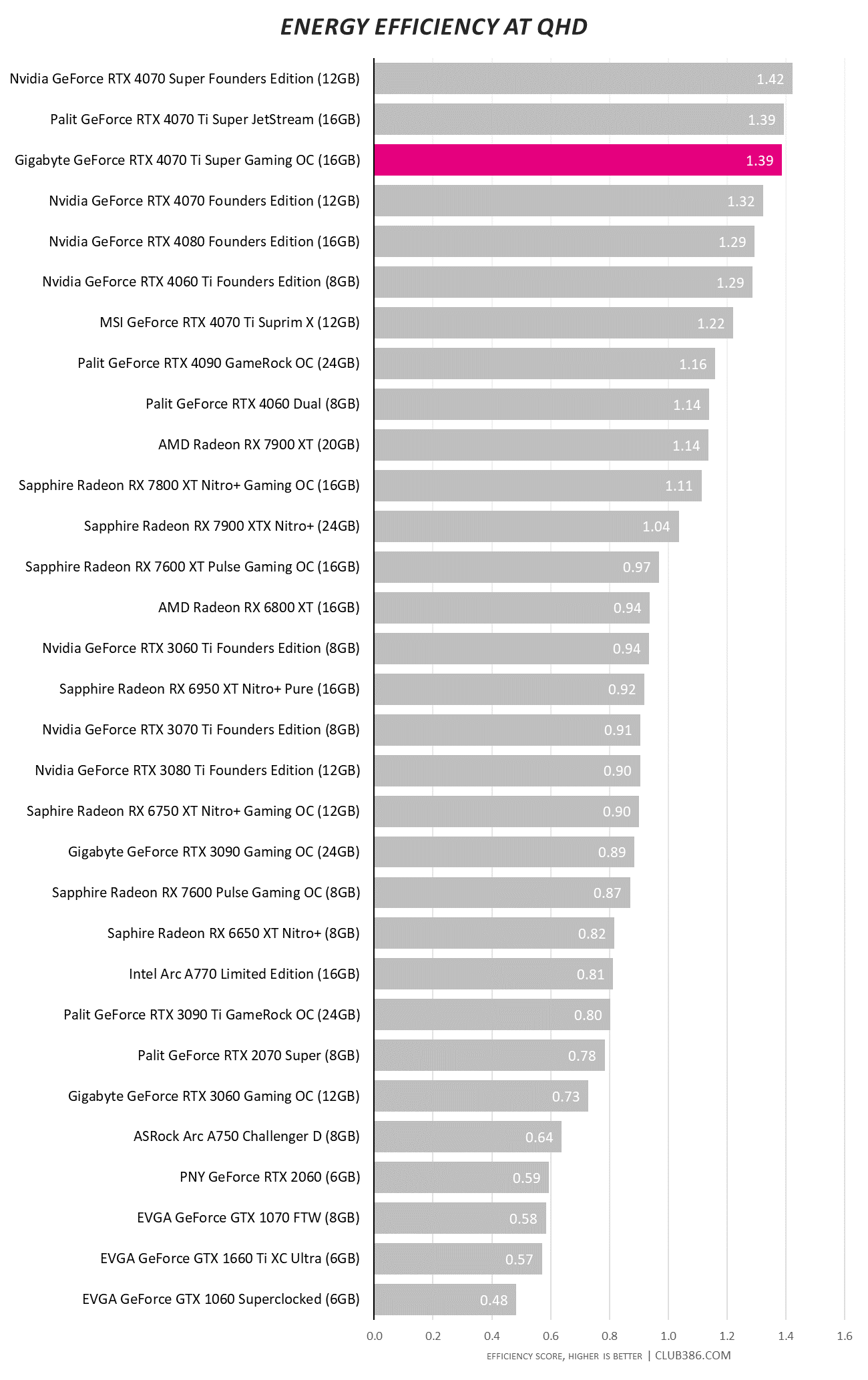
Reasonable energy efficiency and good performance combine to offer this graph. I’ll let it do the talking.
Overclocking
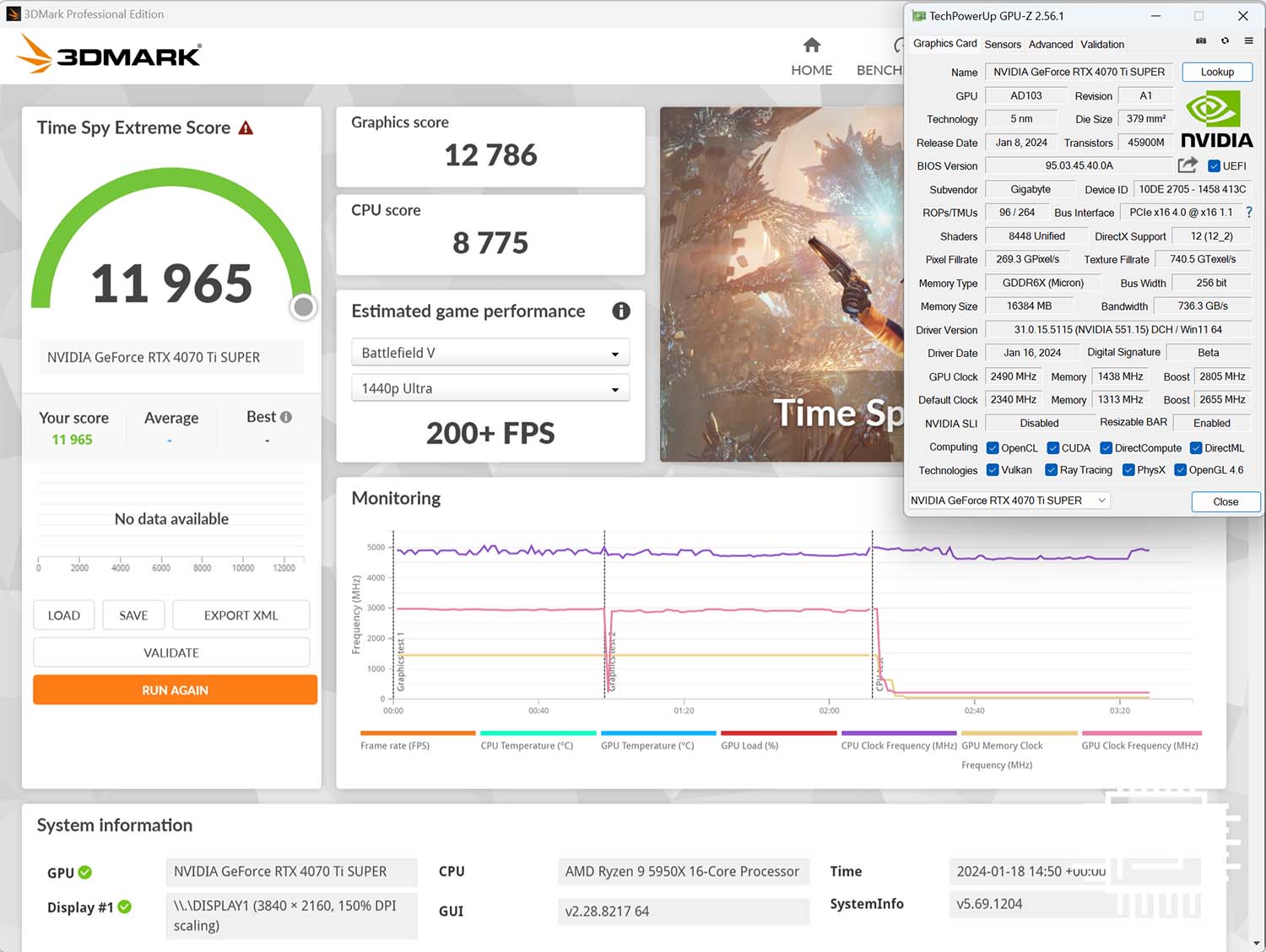
She can take some more, captain. Gigabyte’s card enables a 112% power target. Tinkering around with frequencies leads to a decent uplift.
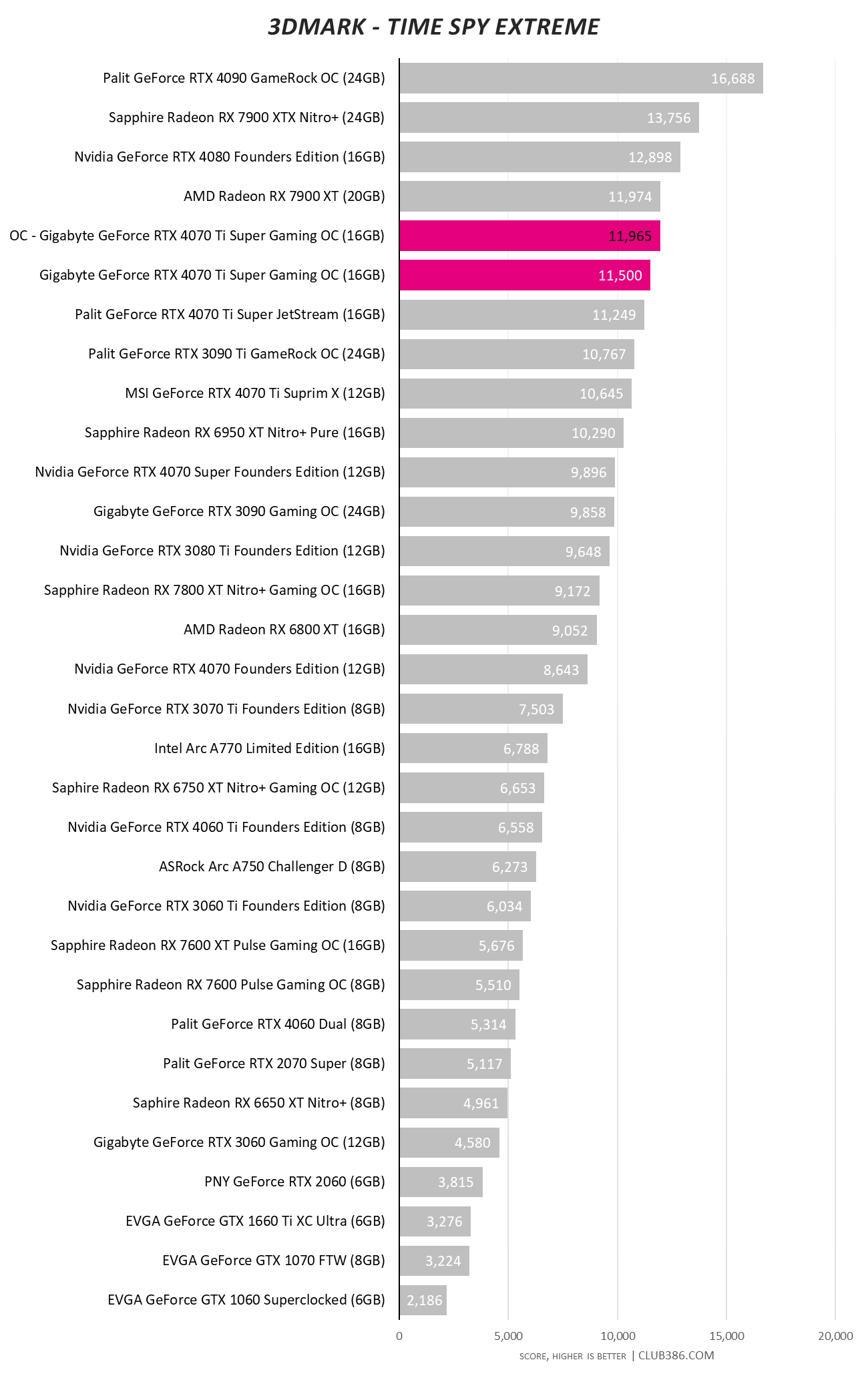
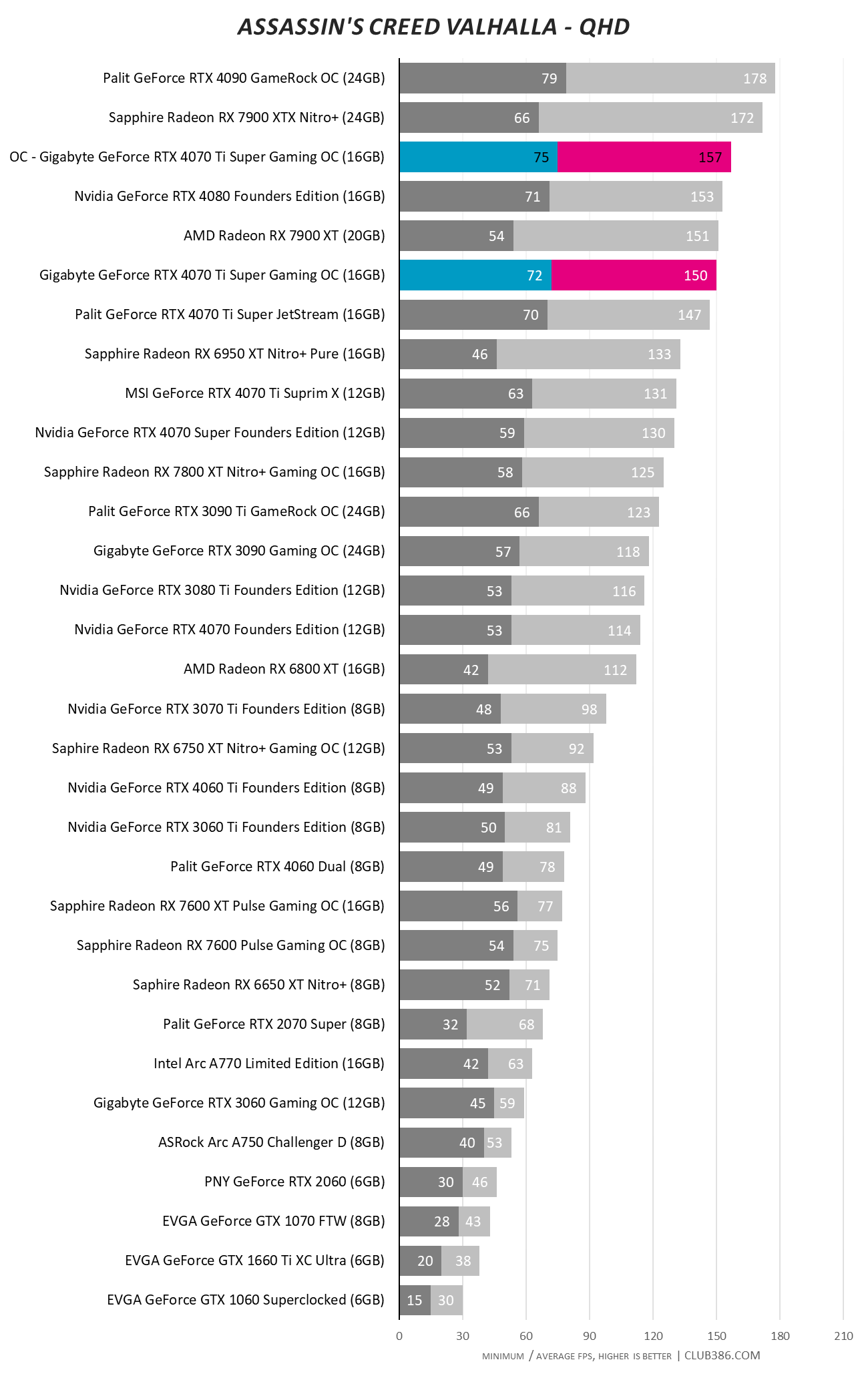
Beating out a pukka RTX 4080 is no easy task, yet here we are.
Conclusion
An RTX 4080 Lite in all but name, the middle Super refresh GPU sets a new standard for the amount of horsepower available at $799. And it needs to because rival AMD Radeon RX 7900 XT gets closer in the rear-view mirror thanks to recent price cuts.
Gigabyte does a fine job with what it has to work with. The Gaming OC is amongst the fastest on offer, reaching a solid 2,820MHz core clock without making a fuss. That’s enough muscle for lusty framerates at QHD, with 4K possible through the use of the latest DLSS 3 technologies.
Mind you, the £870 price is at the upper end of the RTX 4070 Ti Super scale, and the card has legion competitors in the form of Radeon RX 7900 XT / XTX and Nvidia’s own premium RTX 40 Series stable. Nevertheless, the overall quality literally shines through, making it a good choice for a premium PC build in 2024.
Verdict: a beast of a card that chews through fps like no tomorrow.


